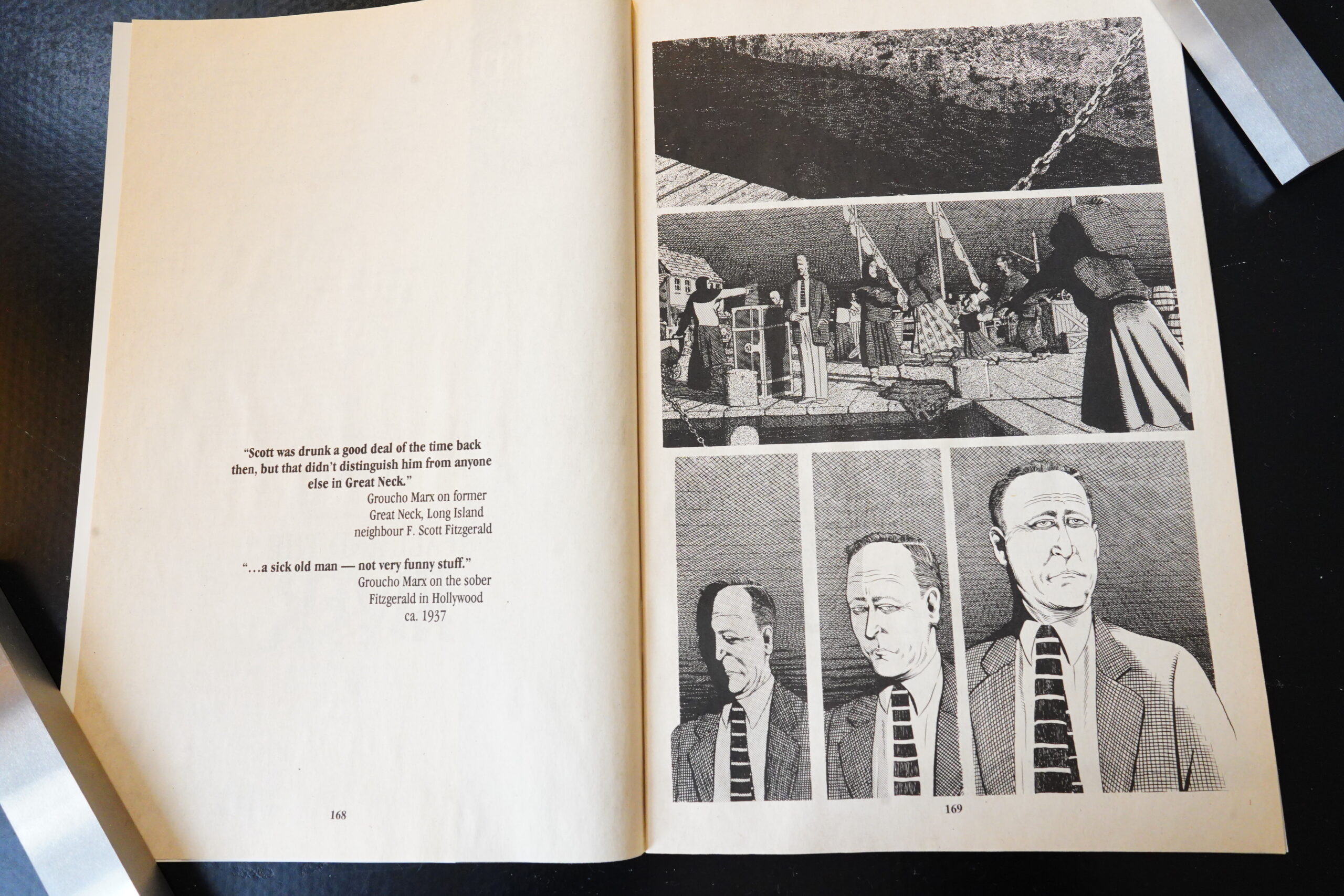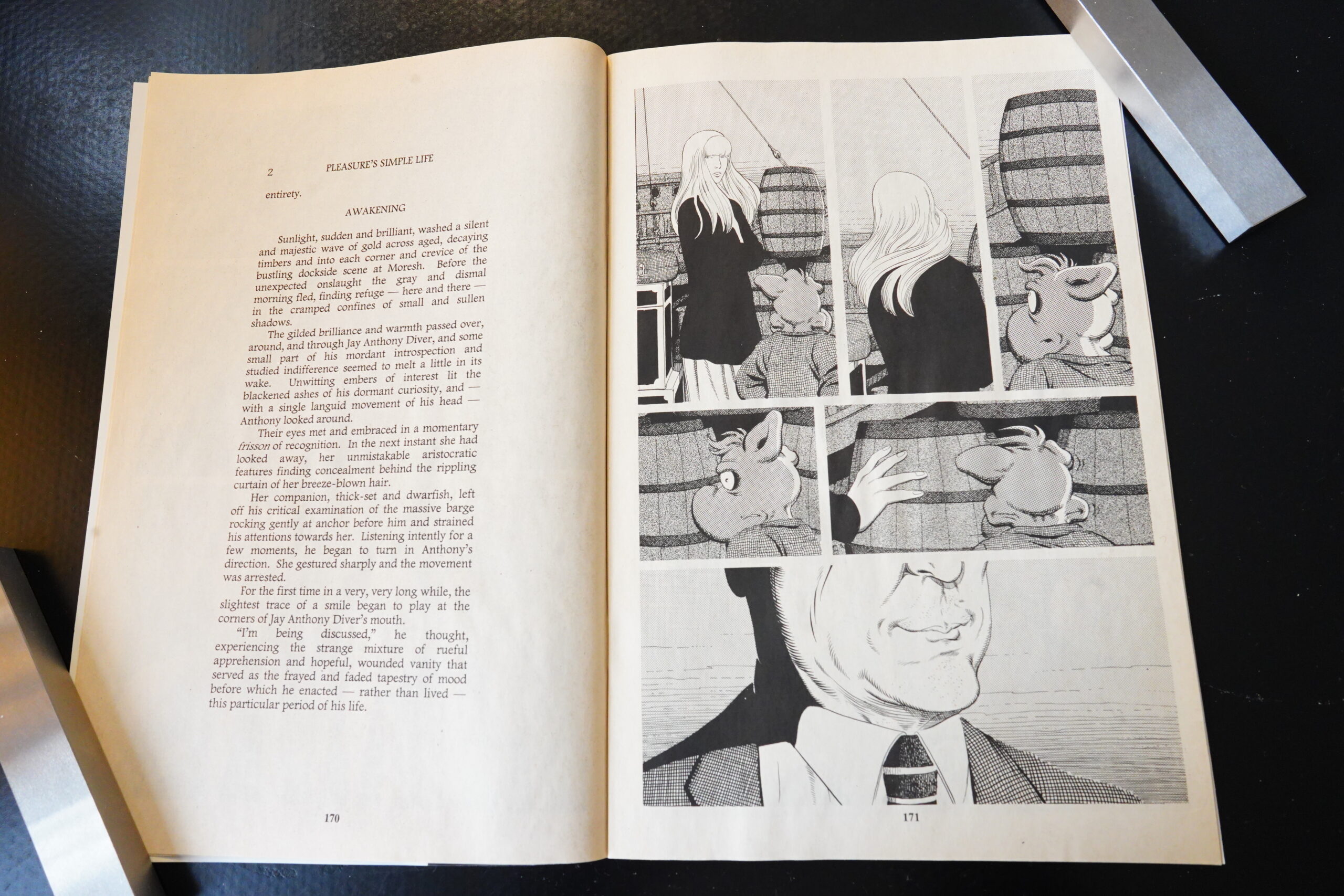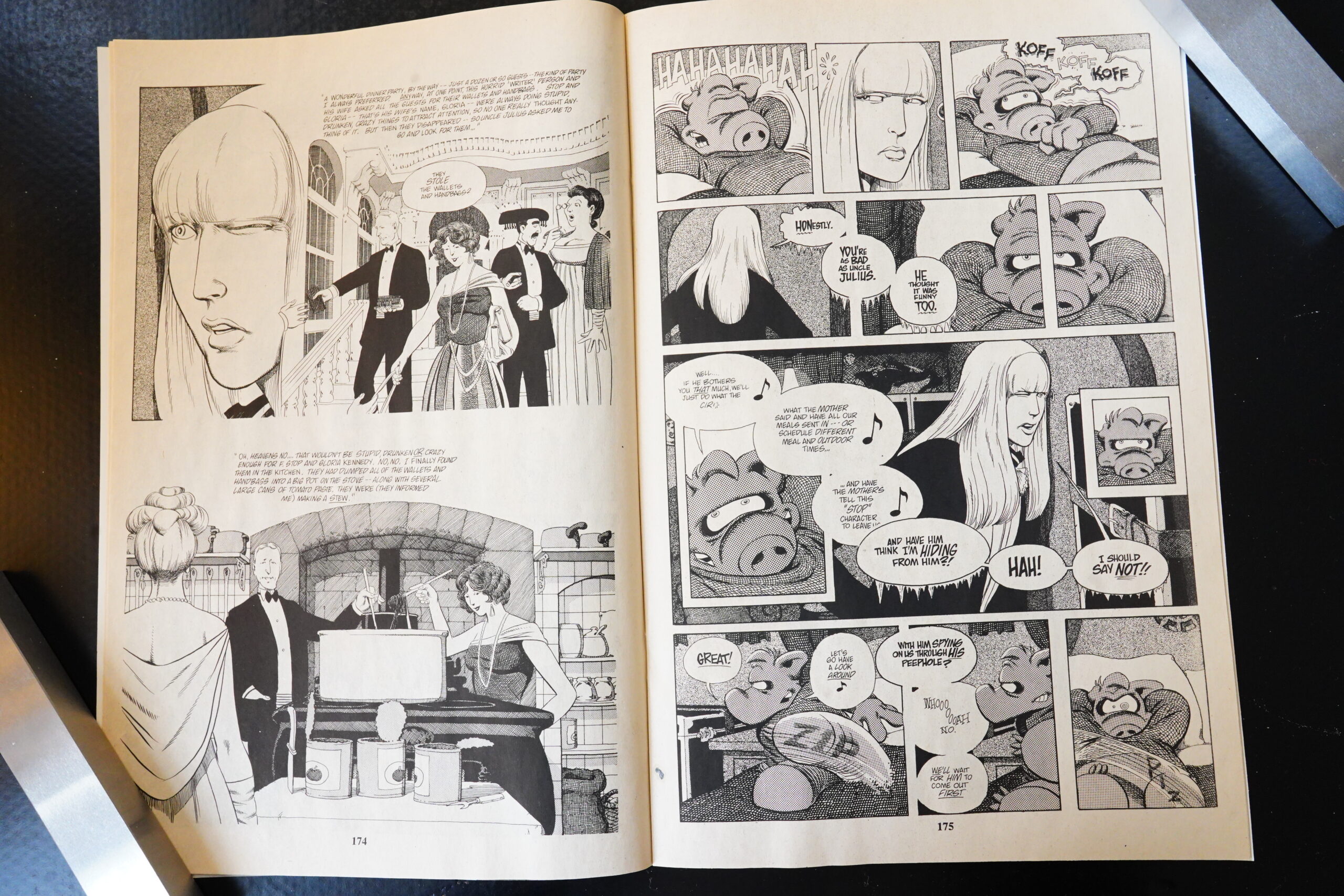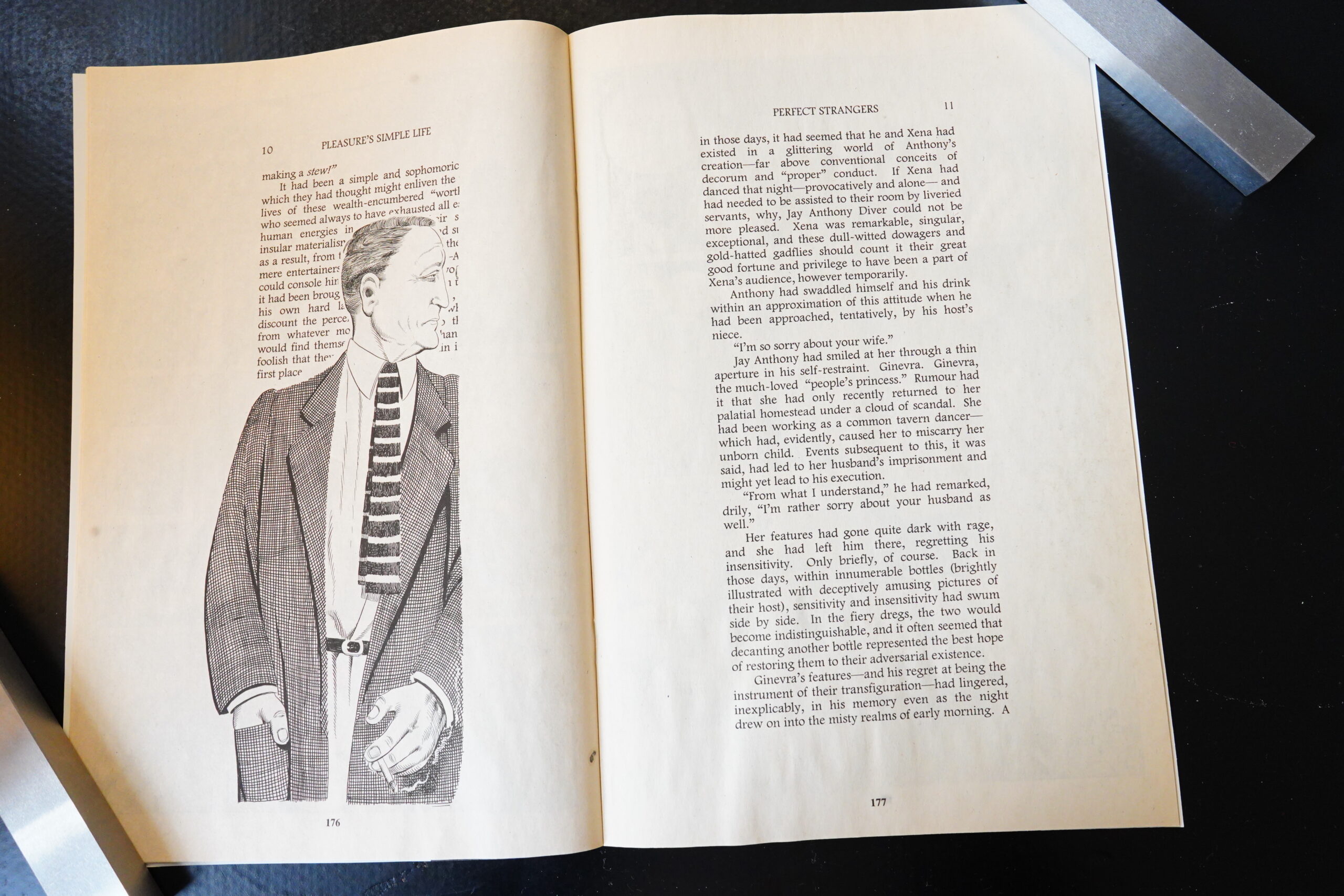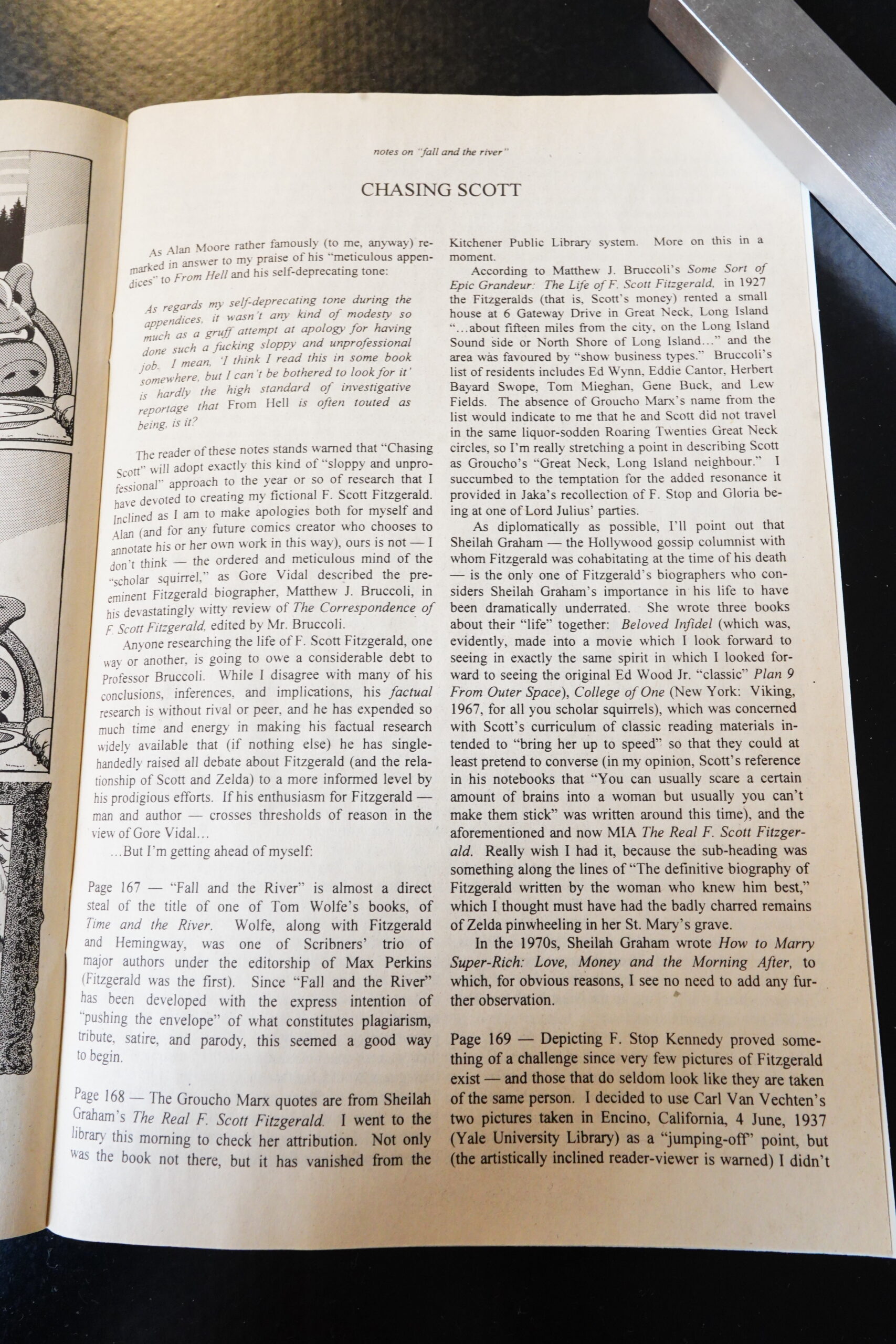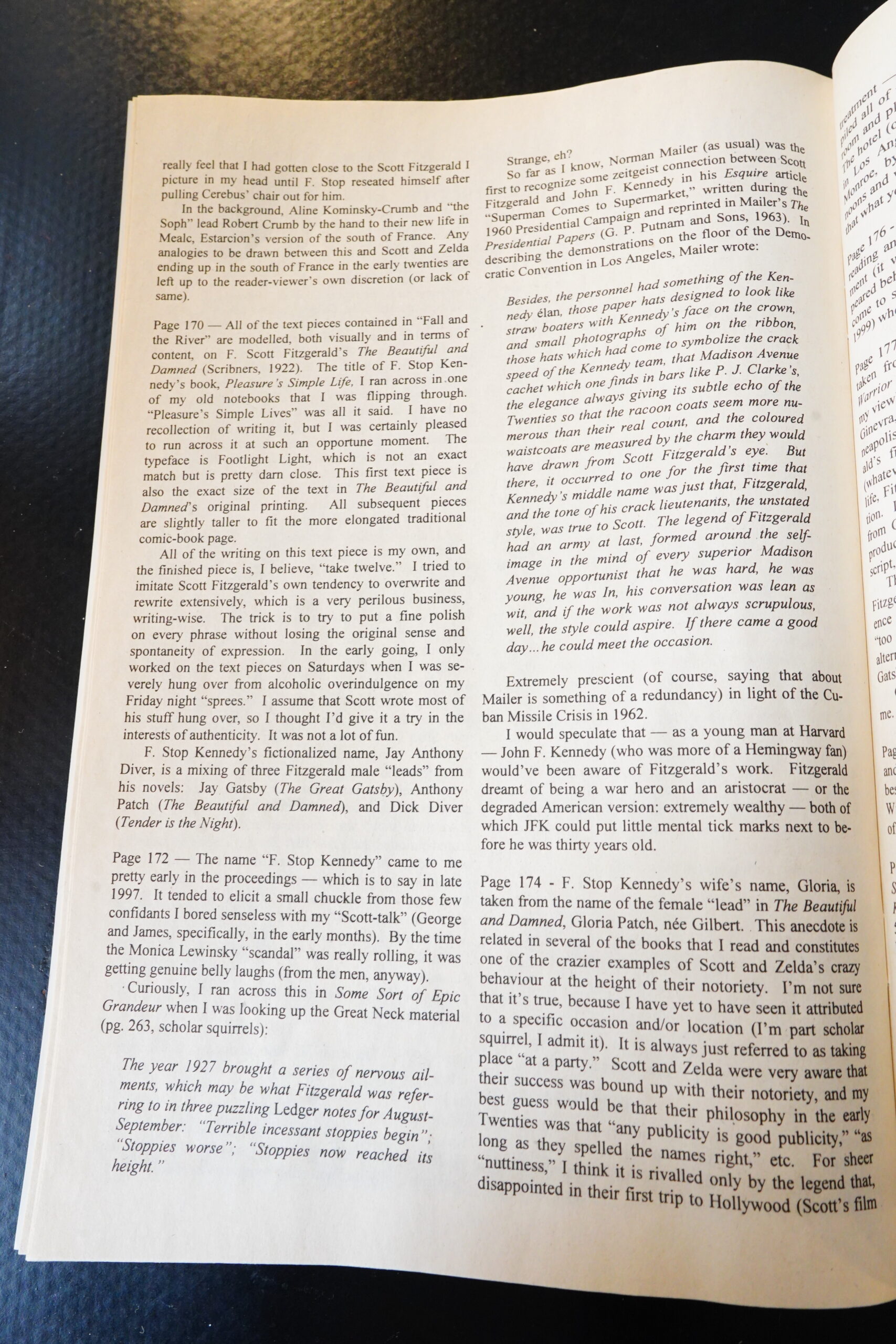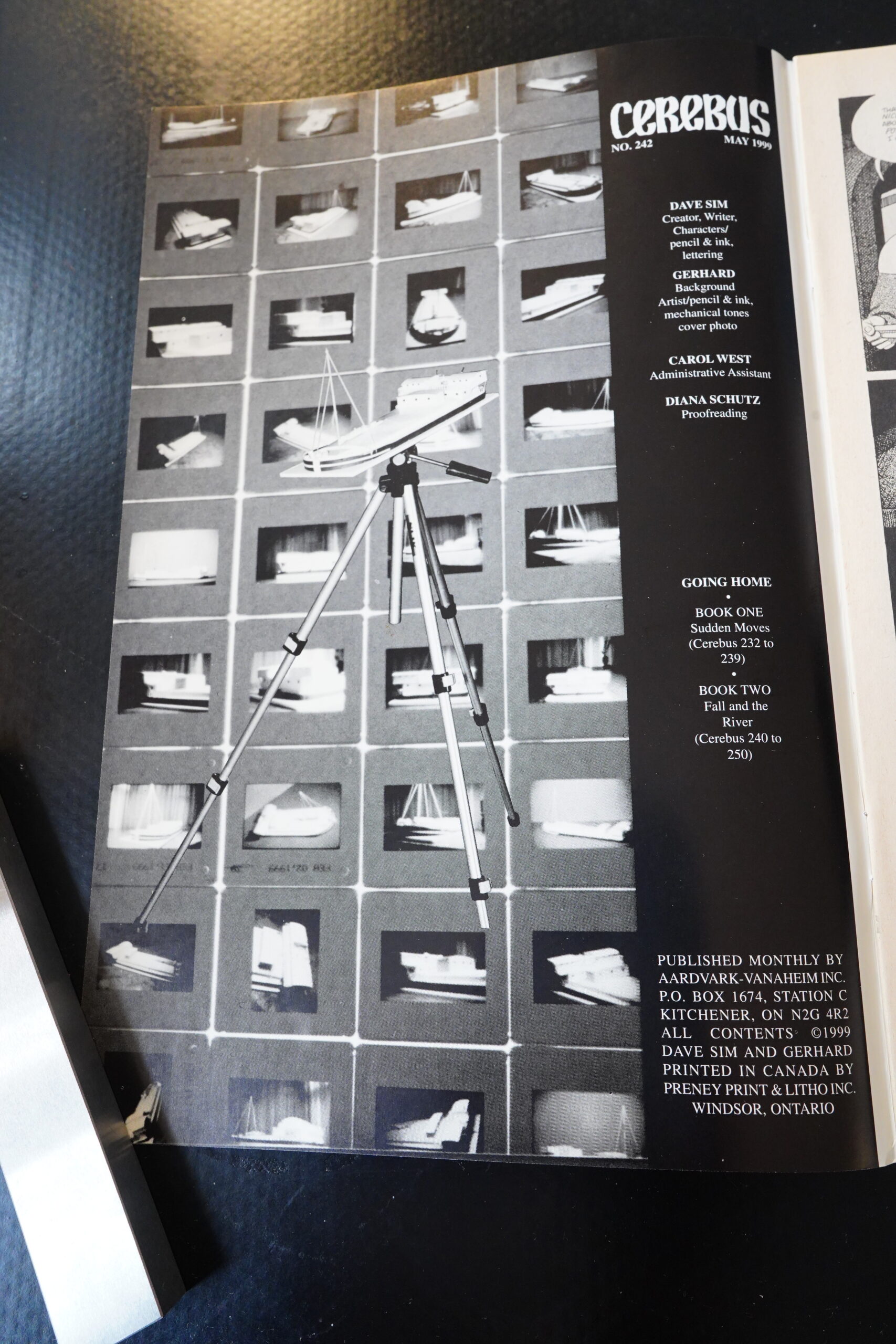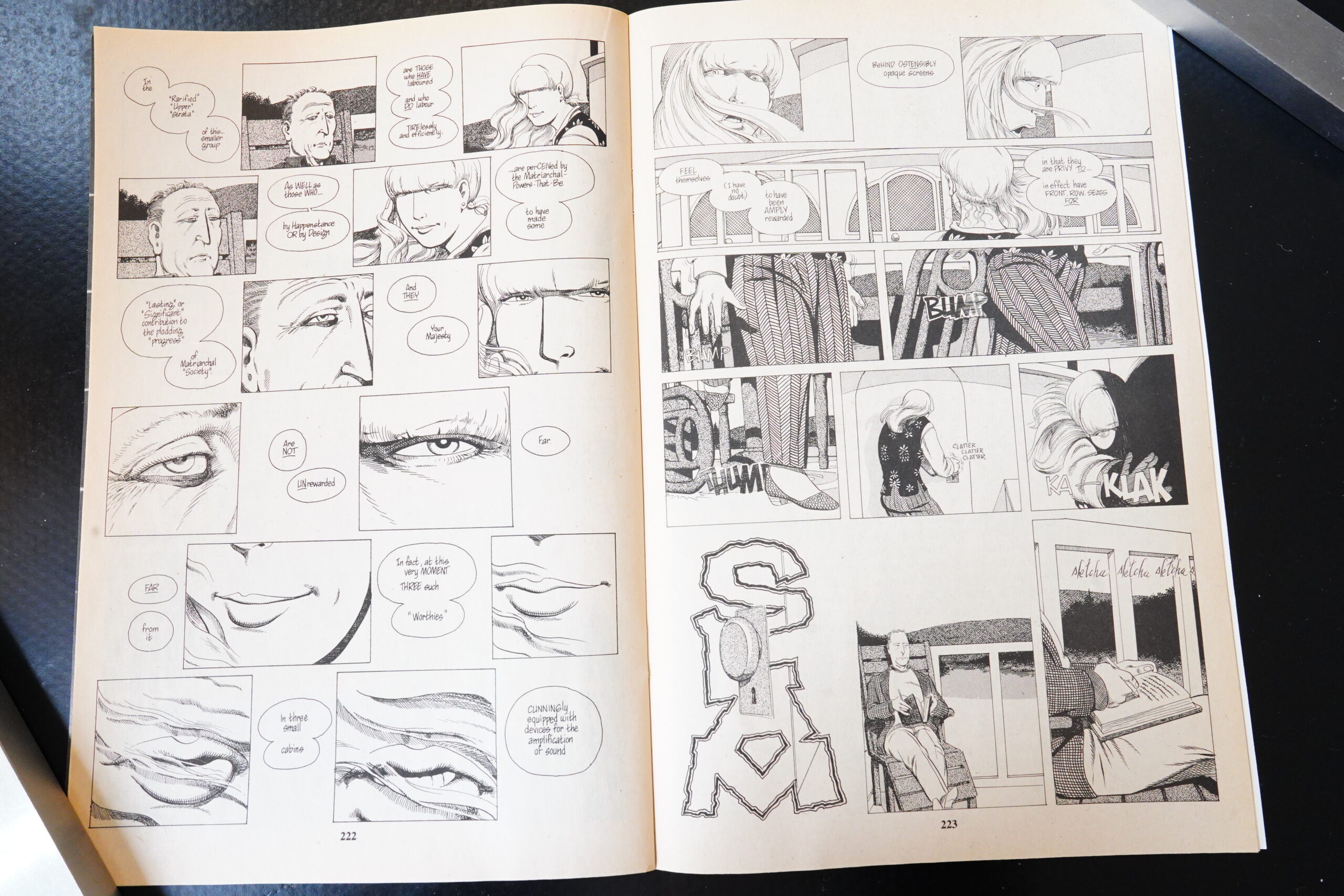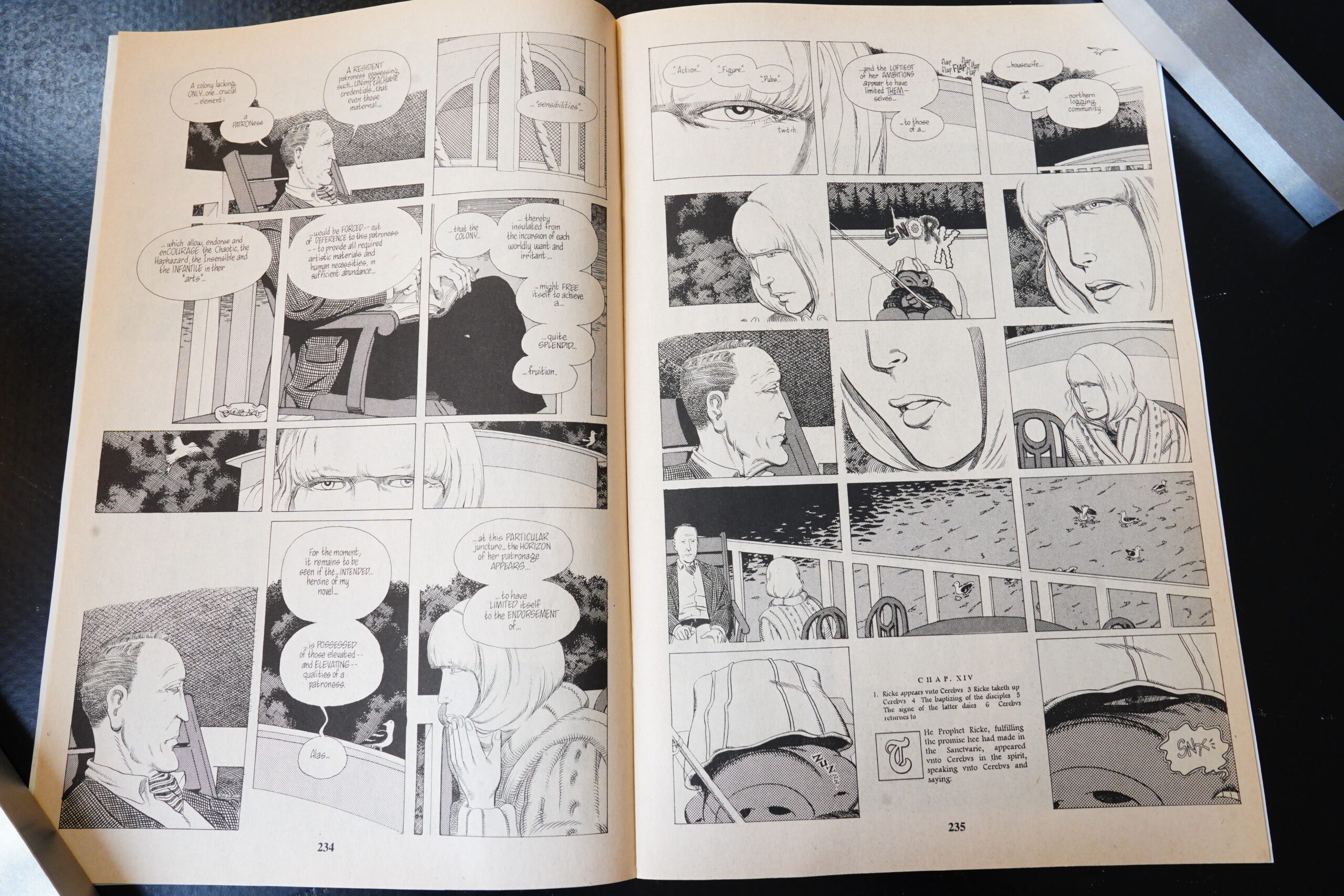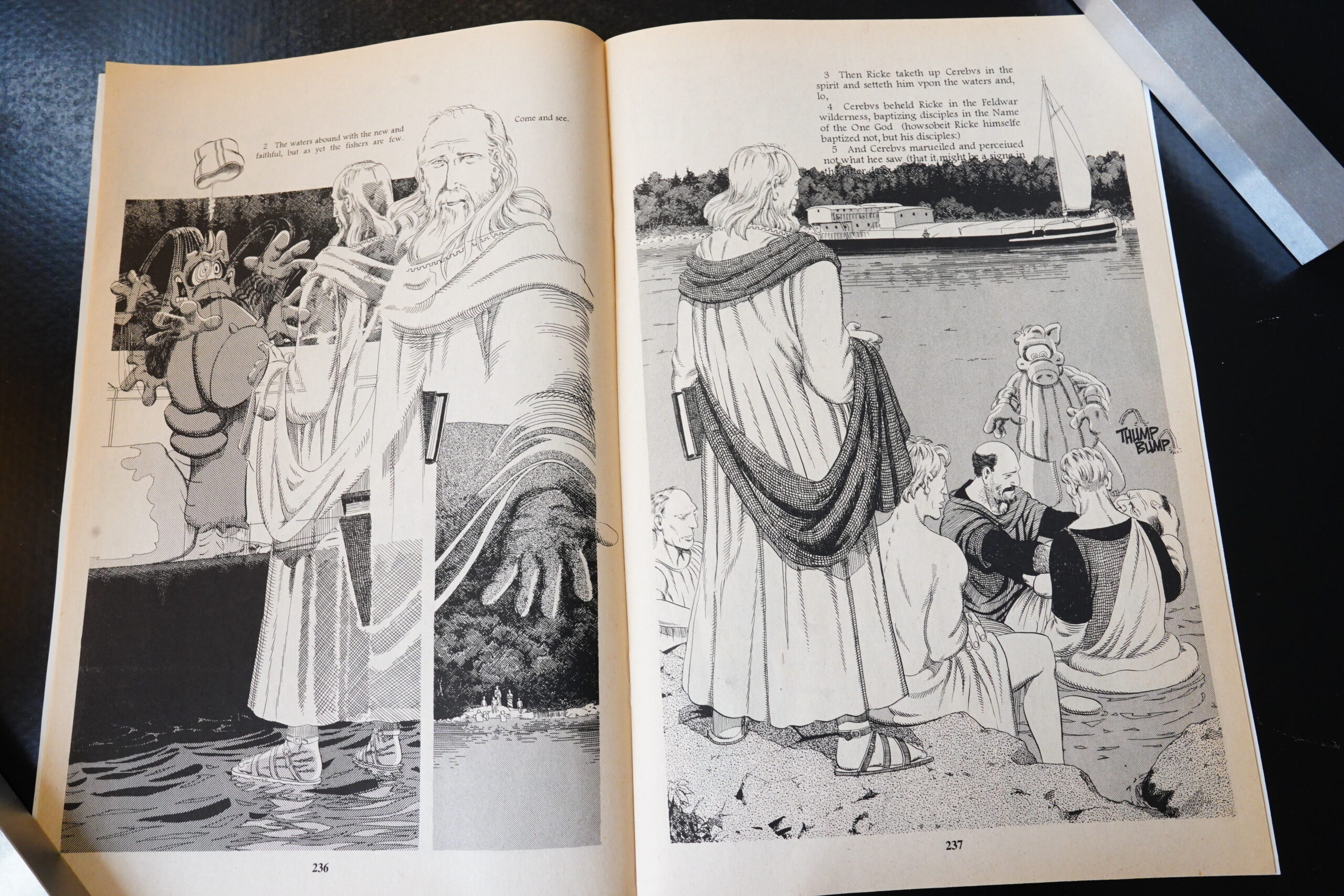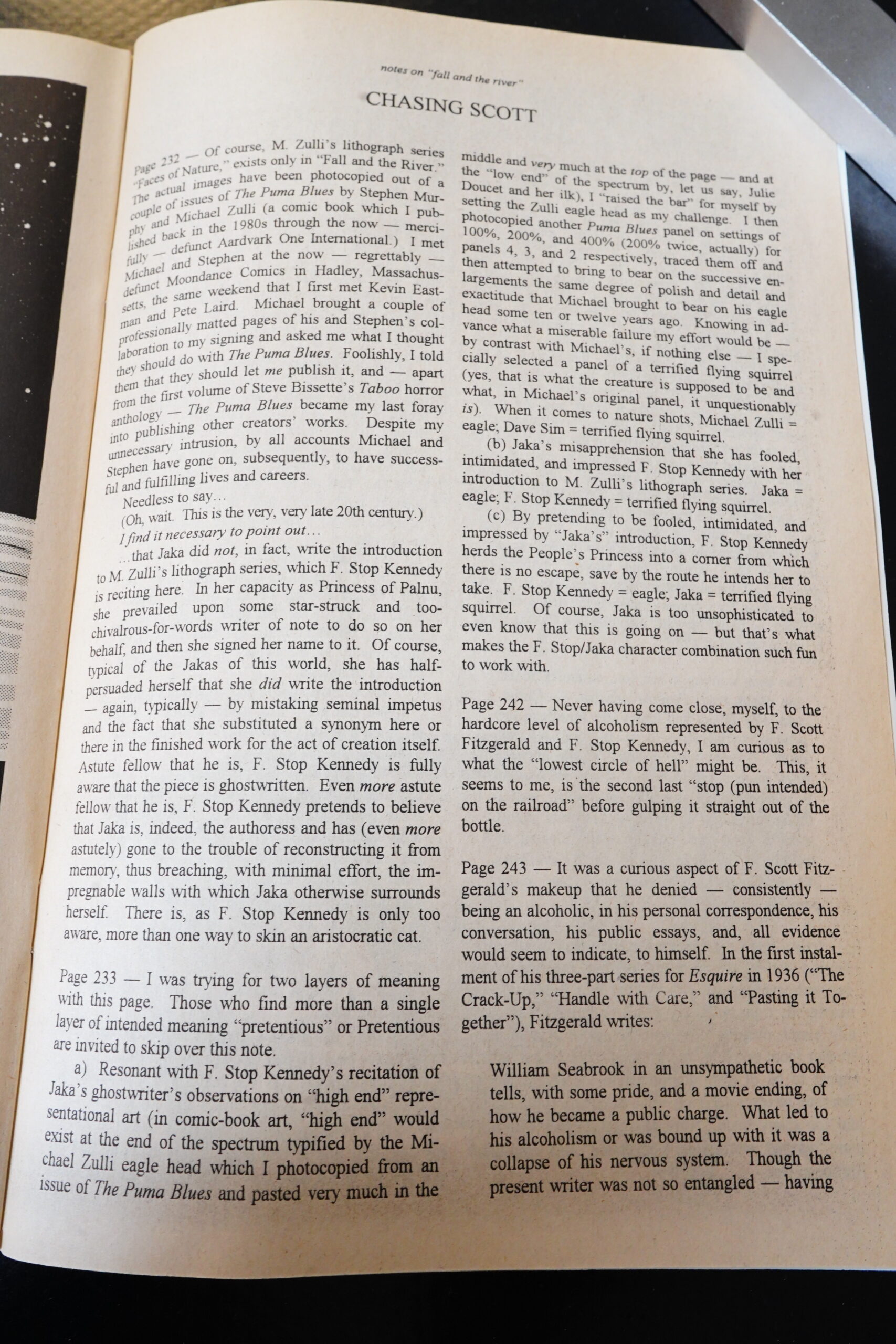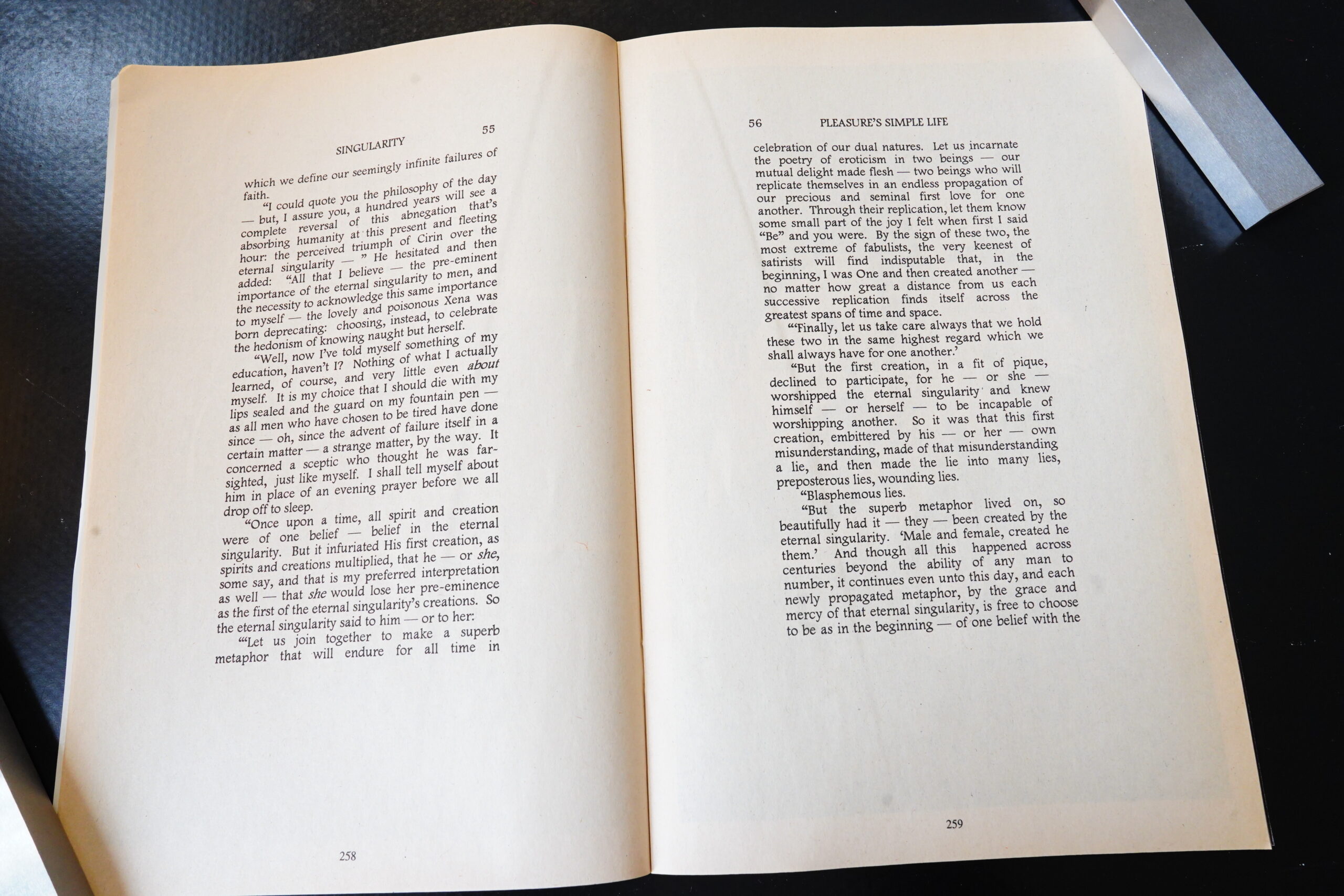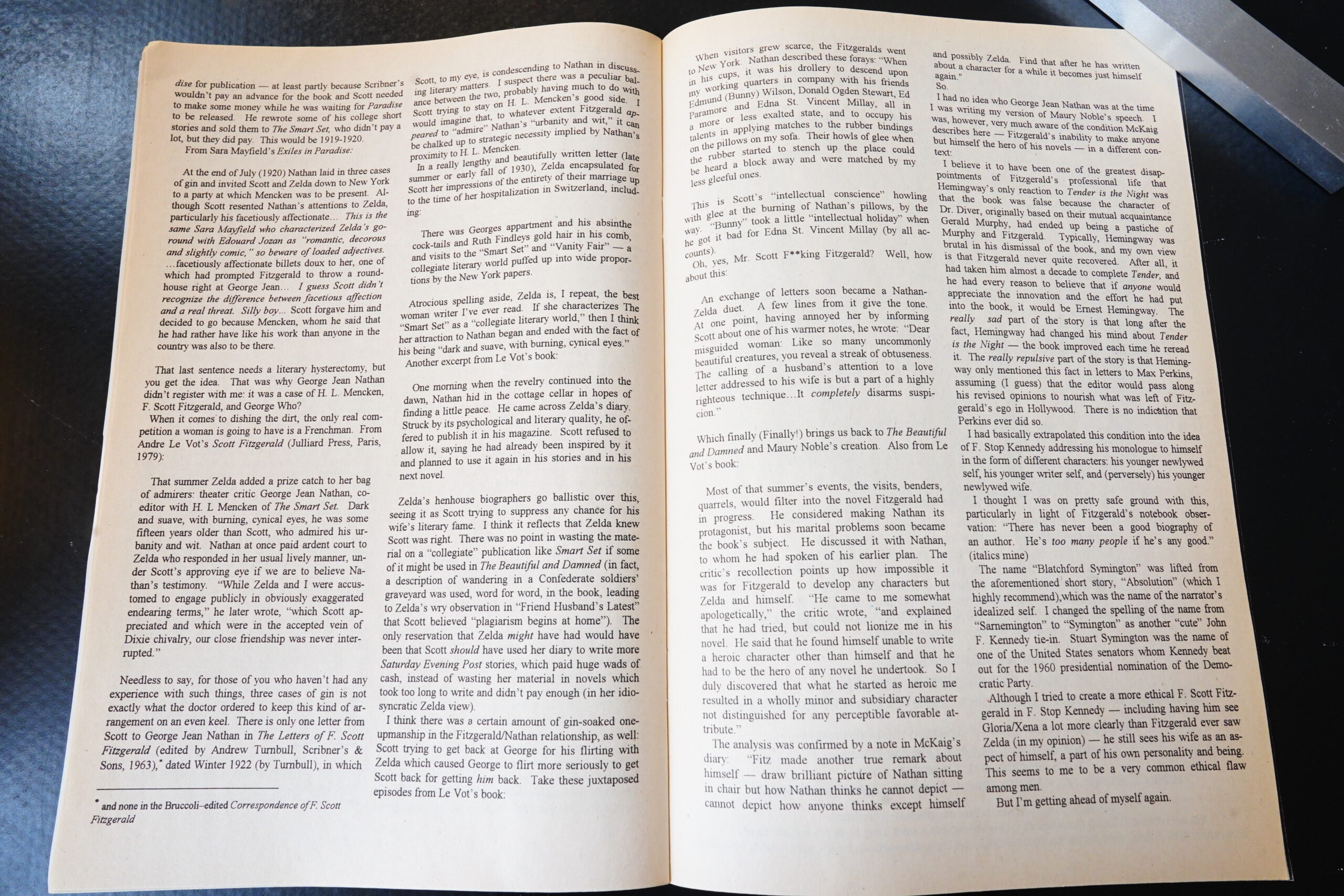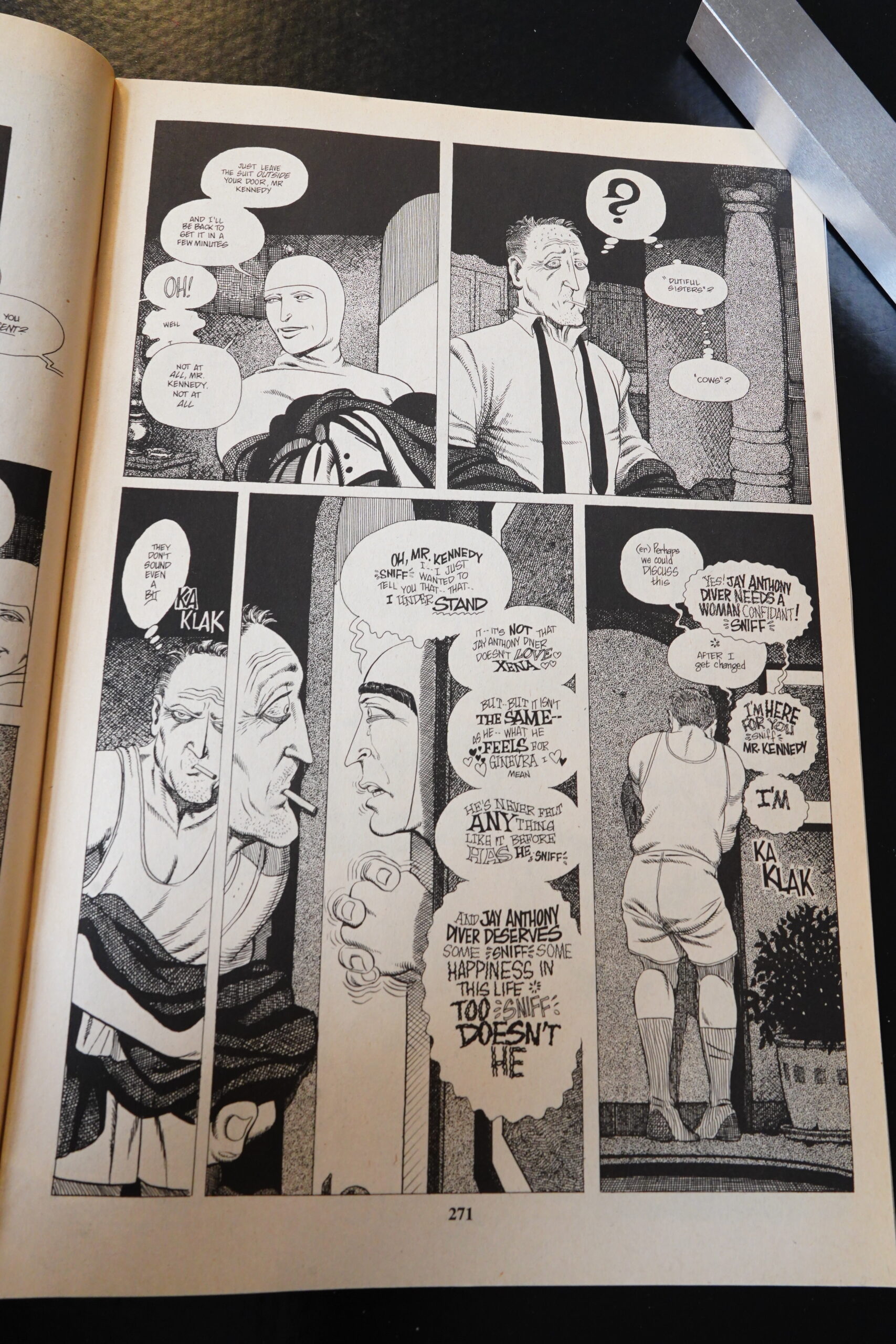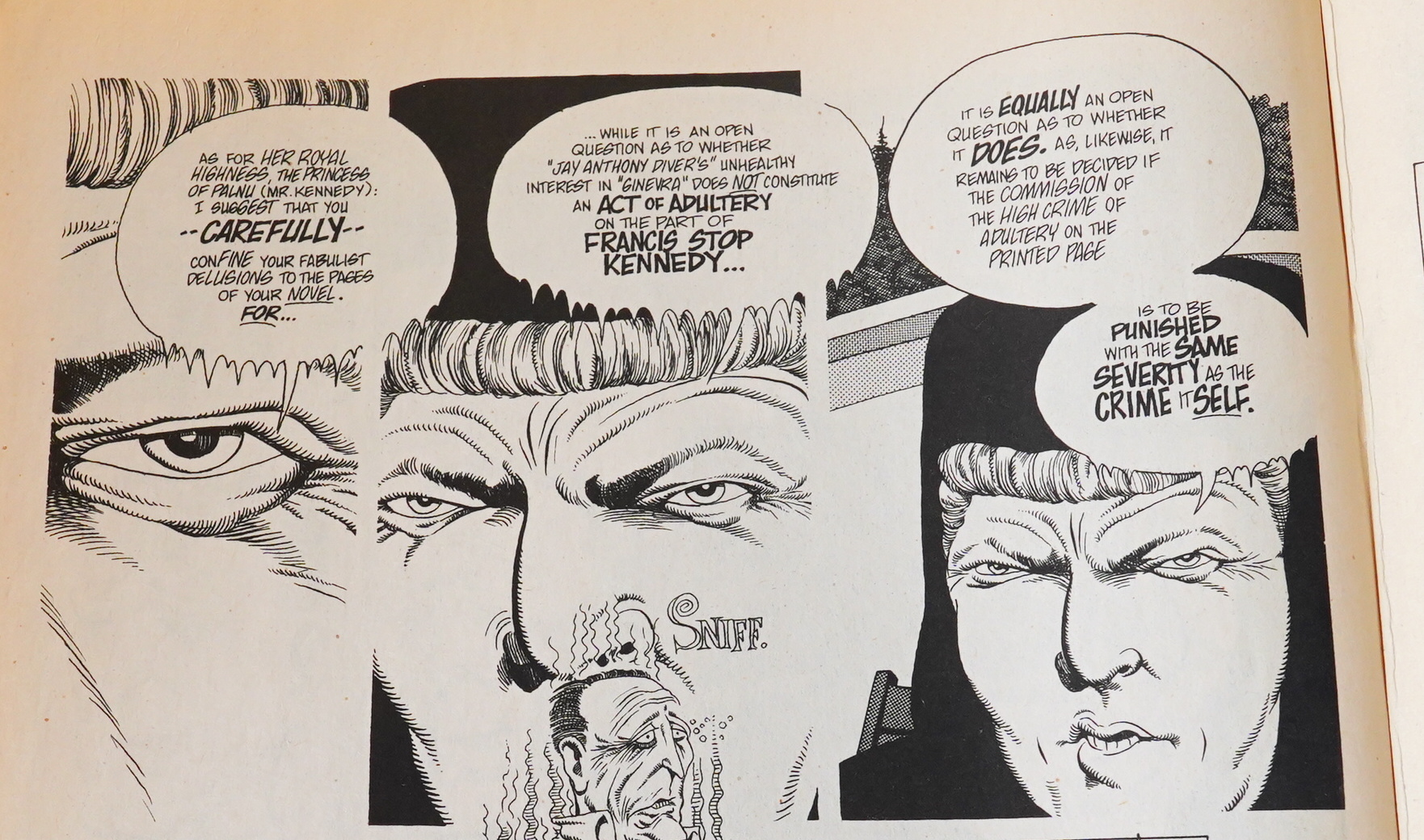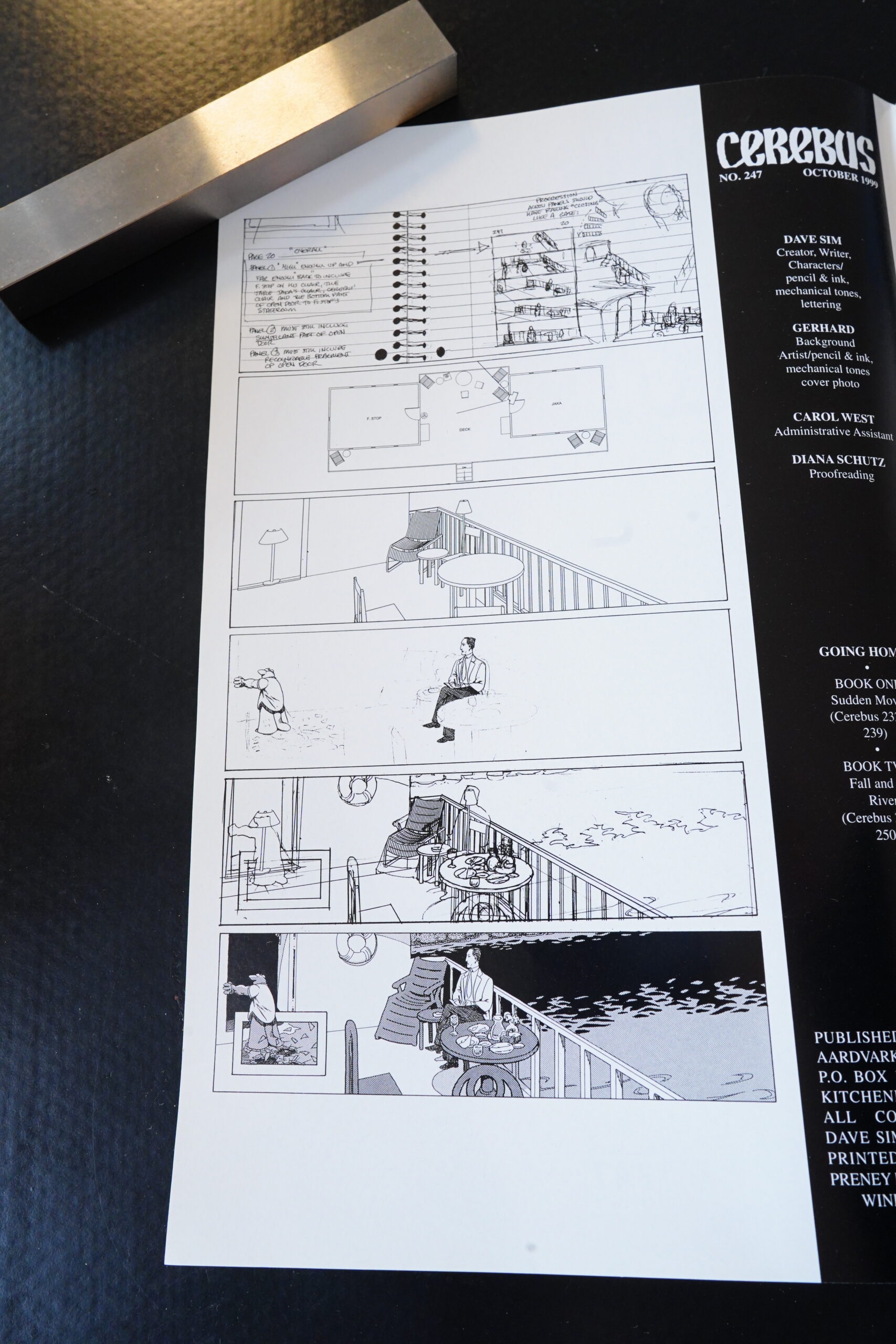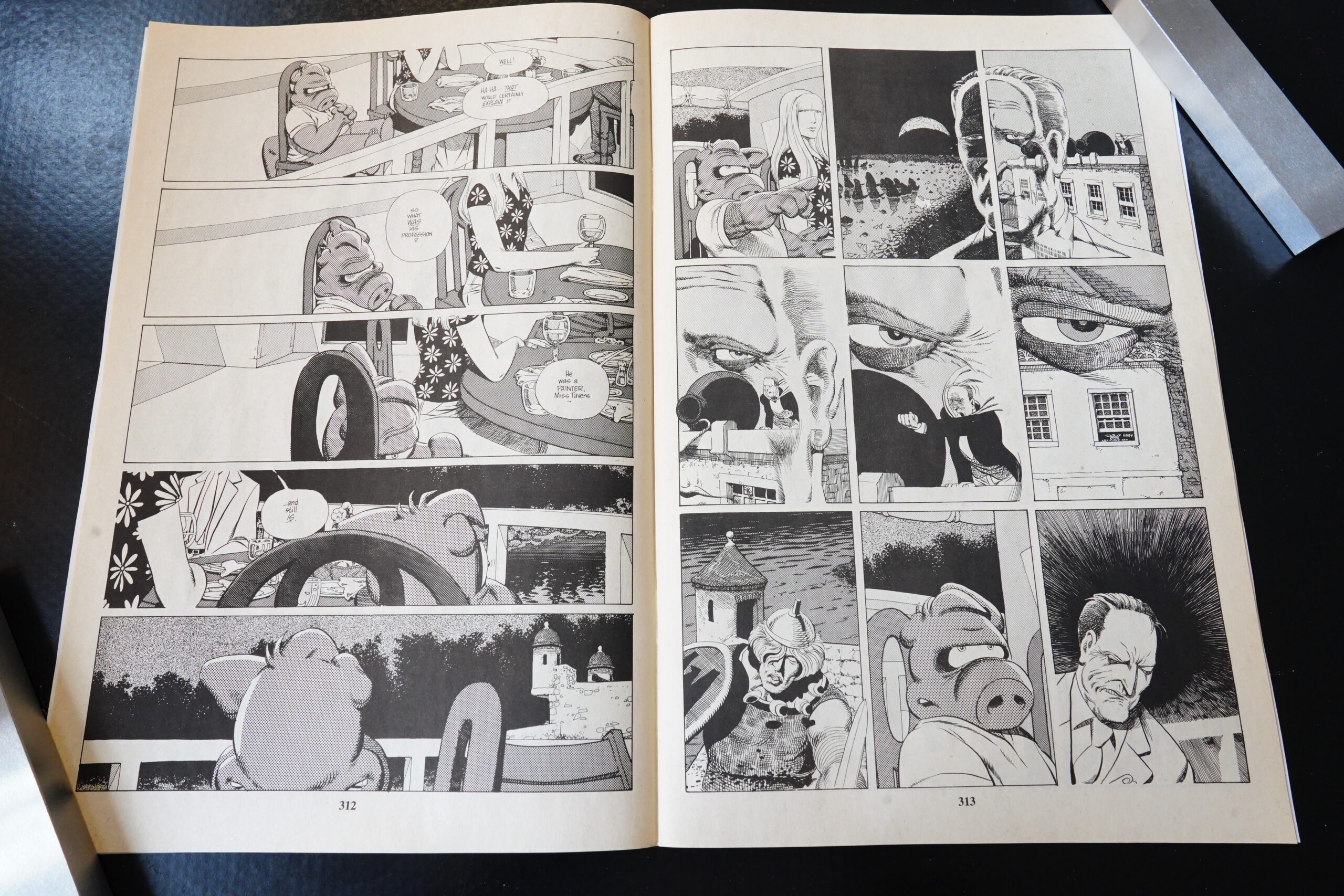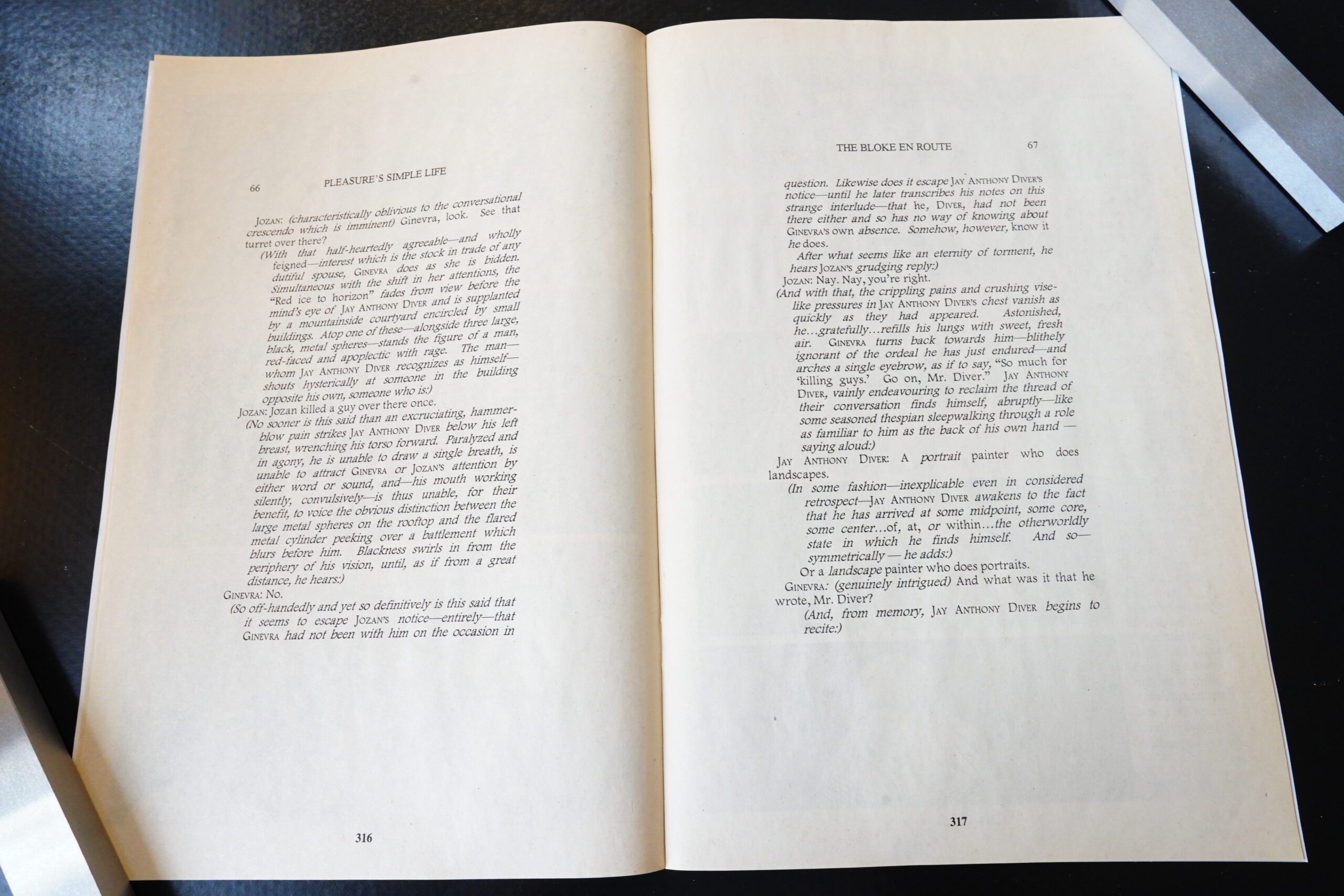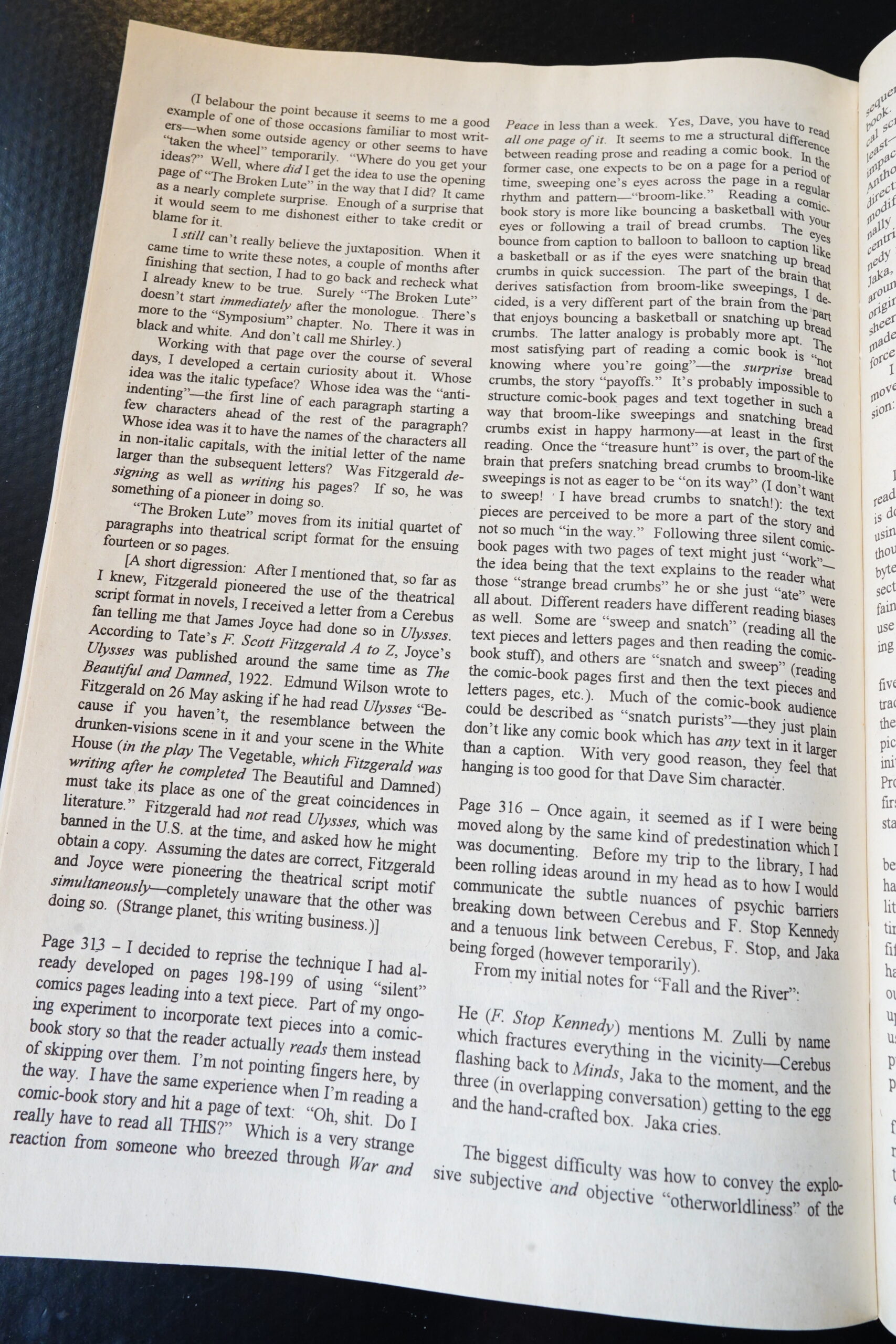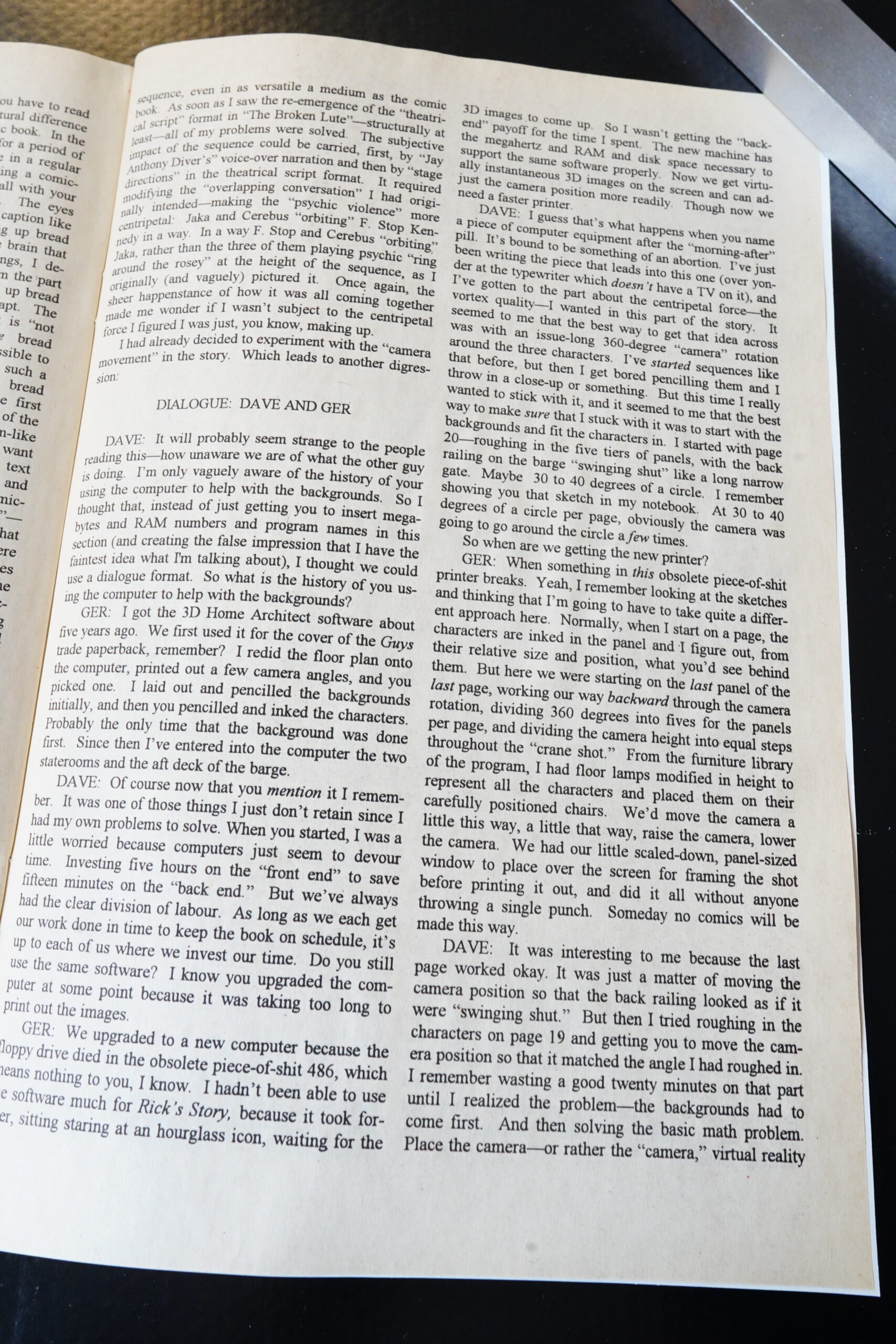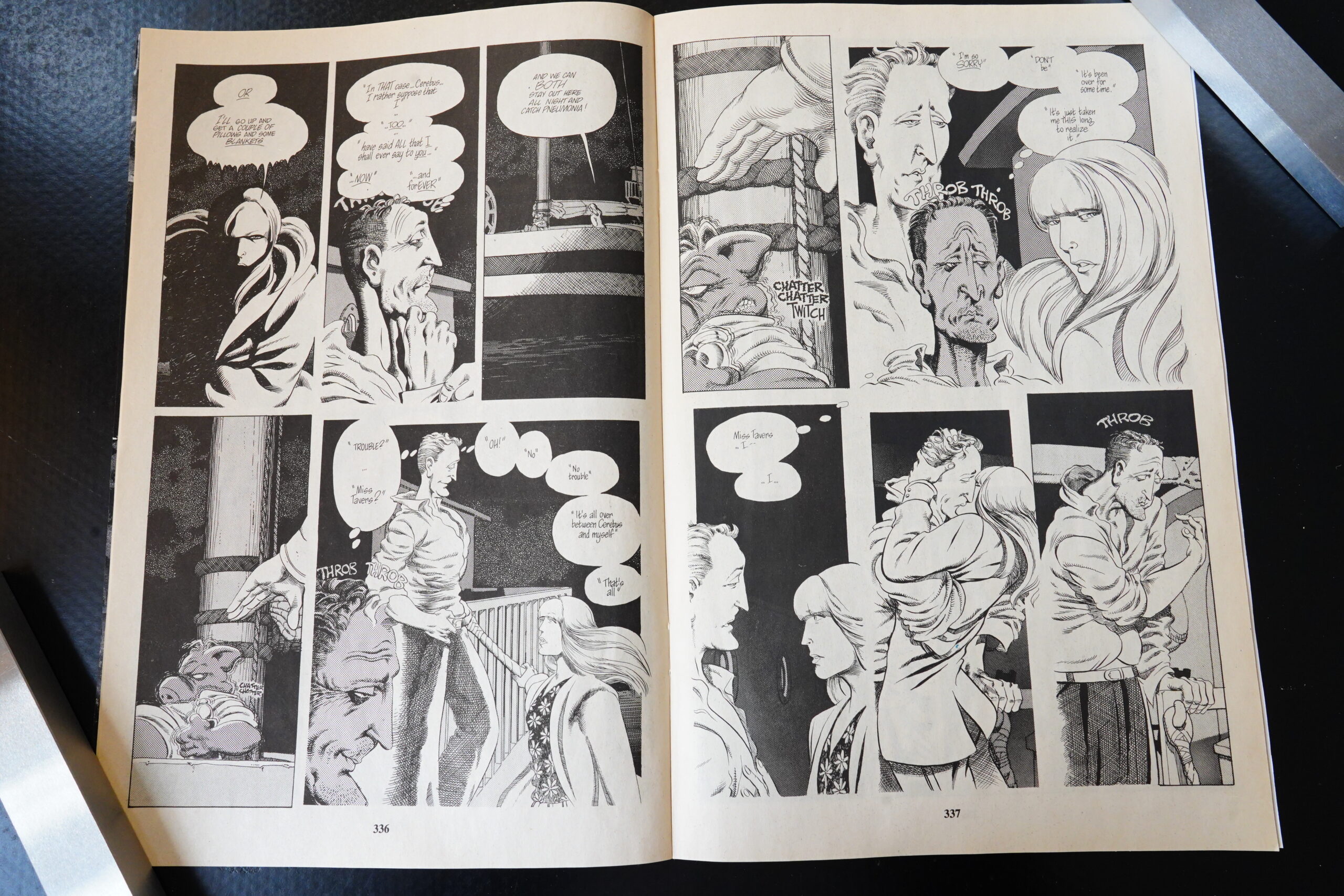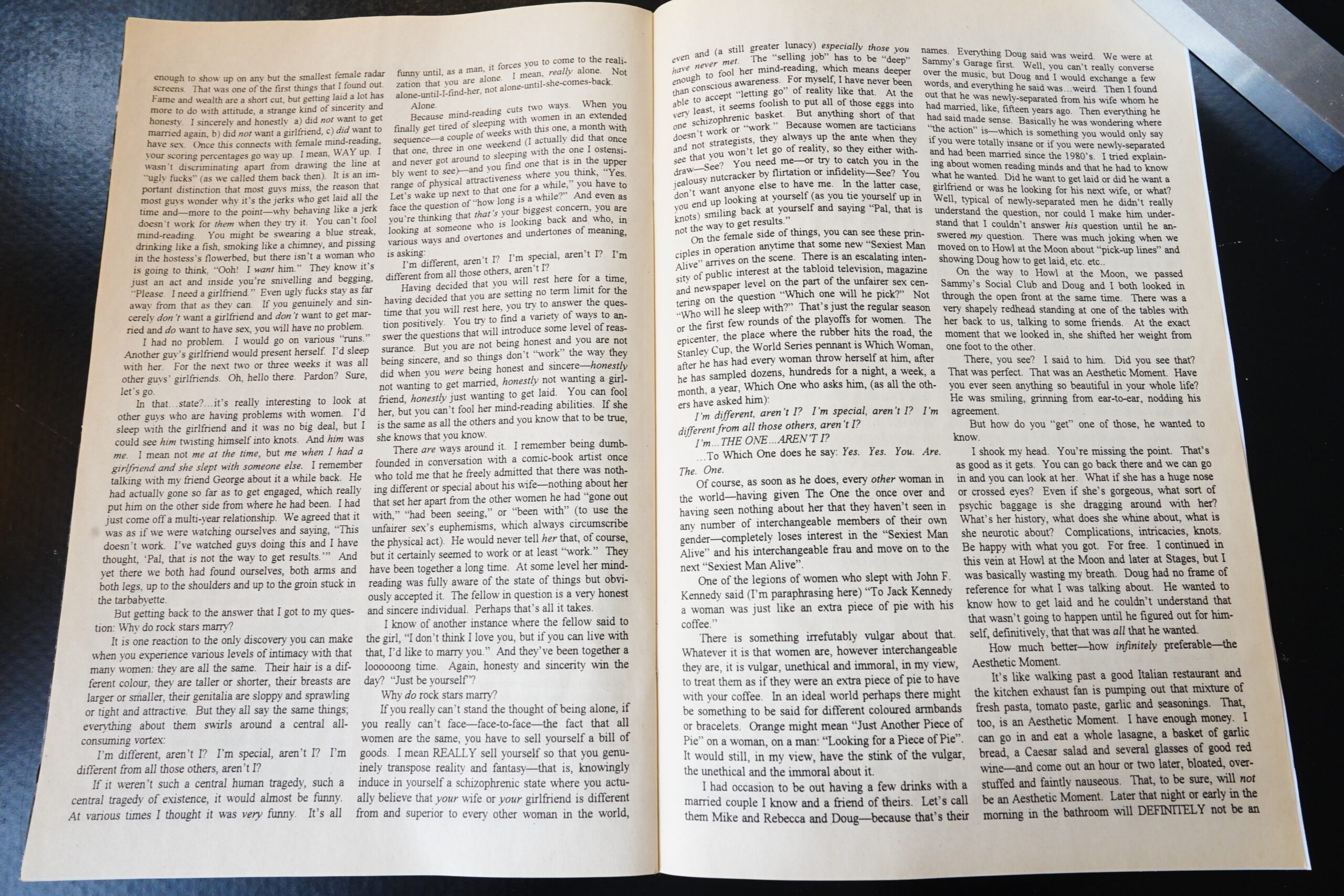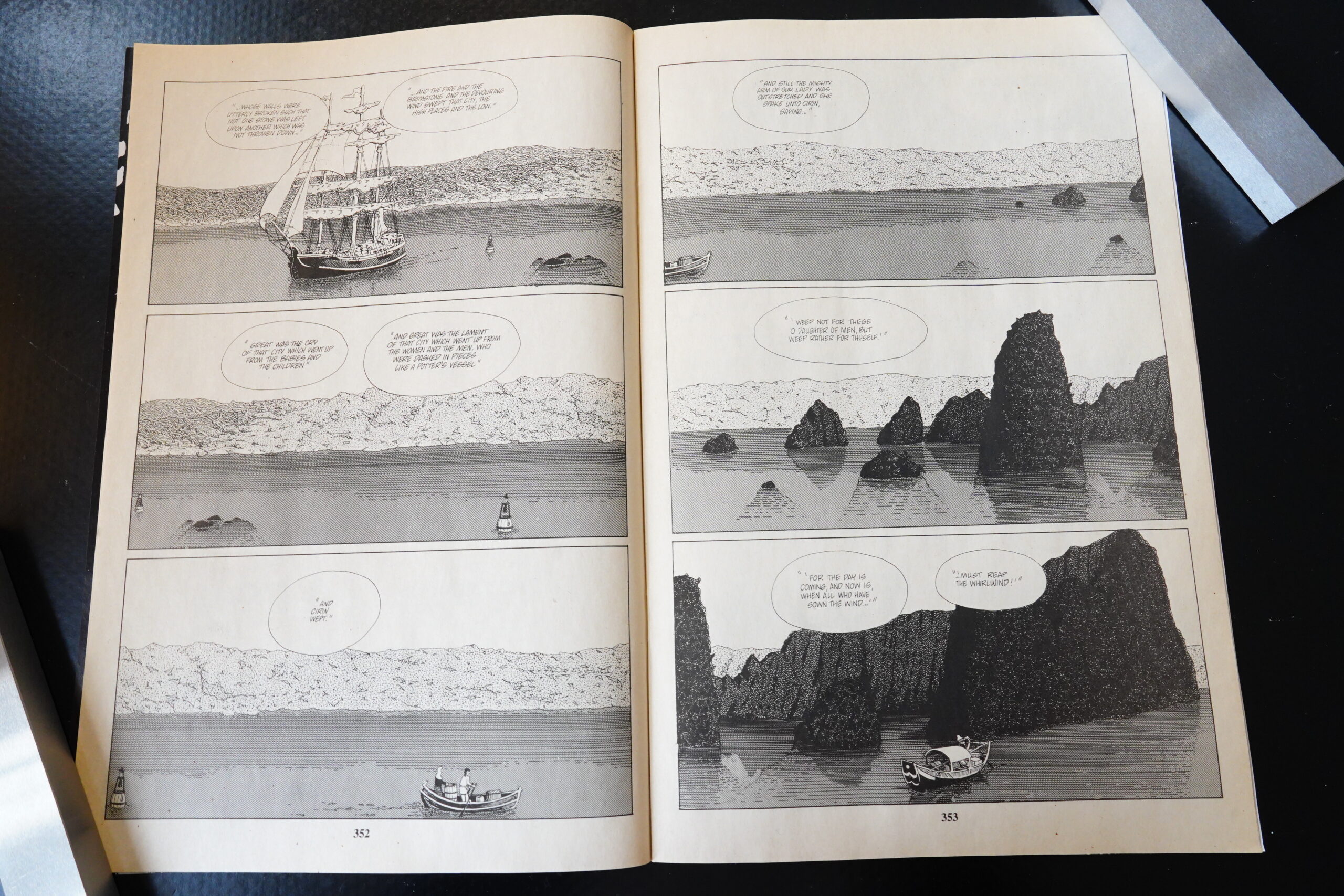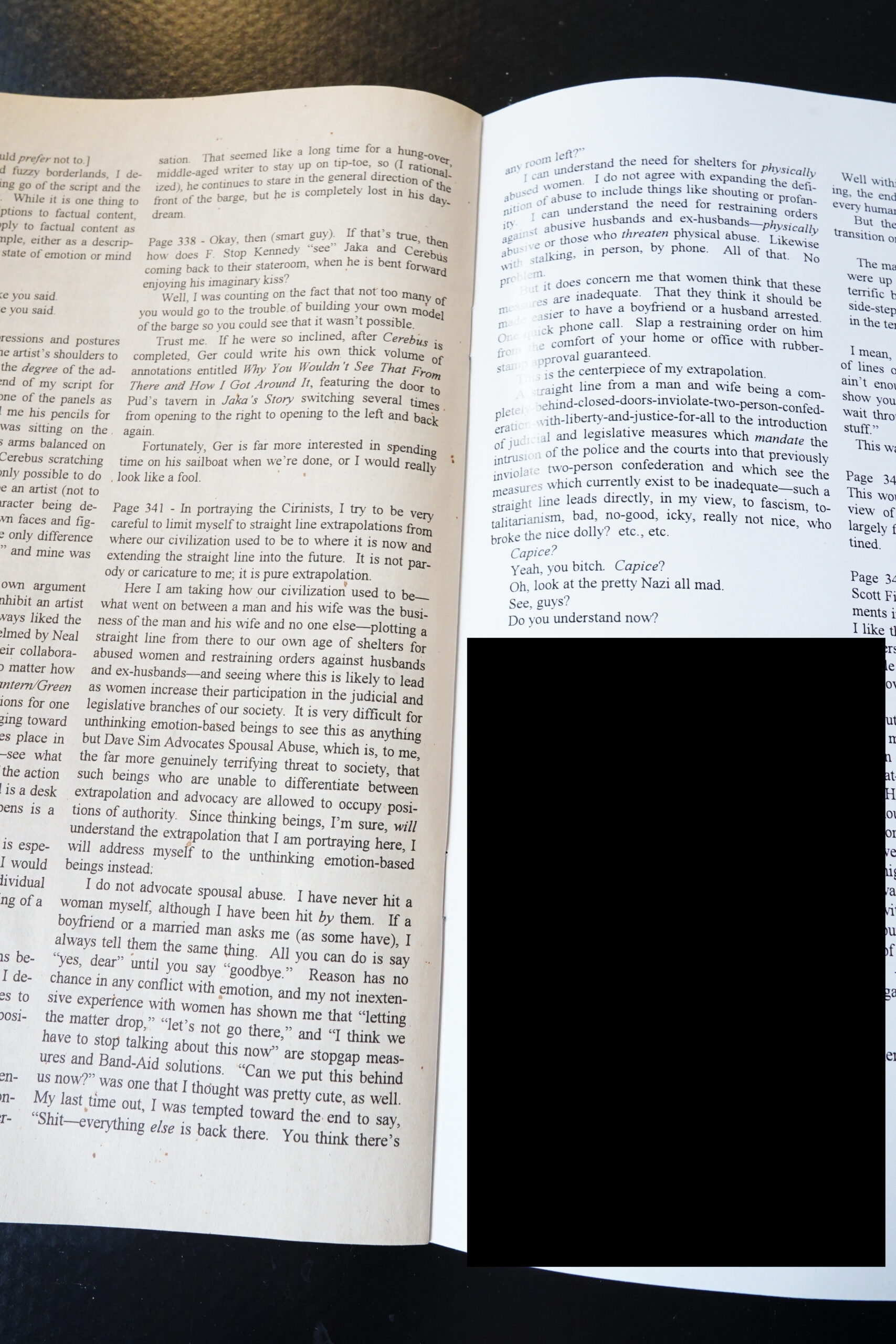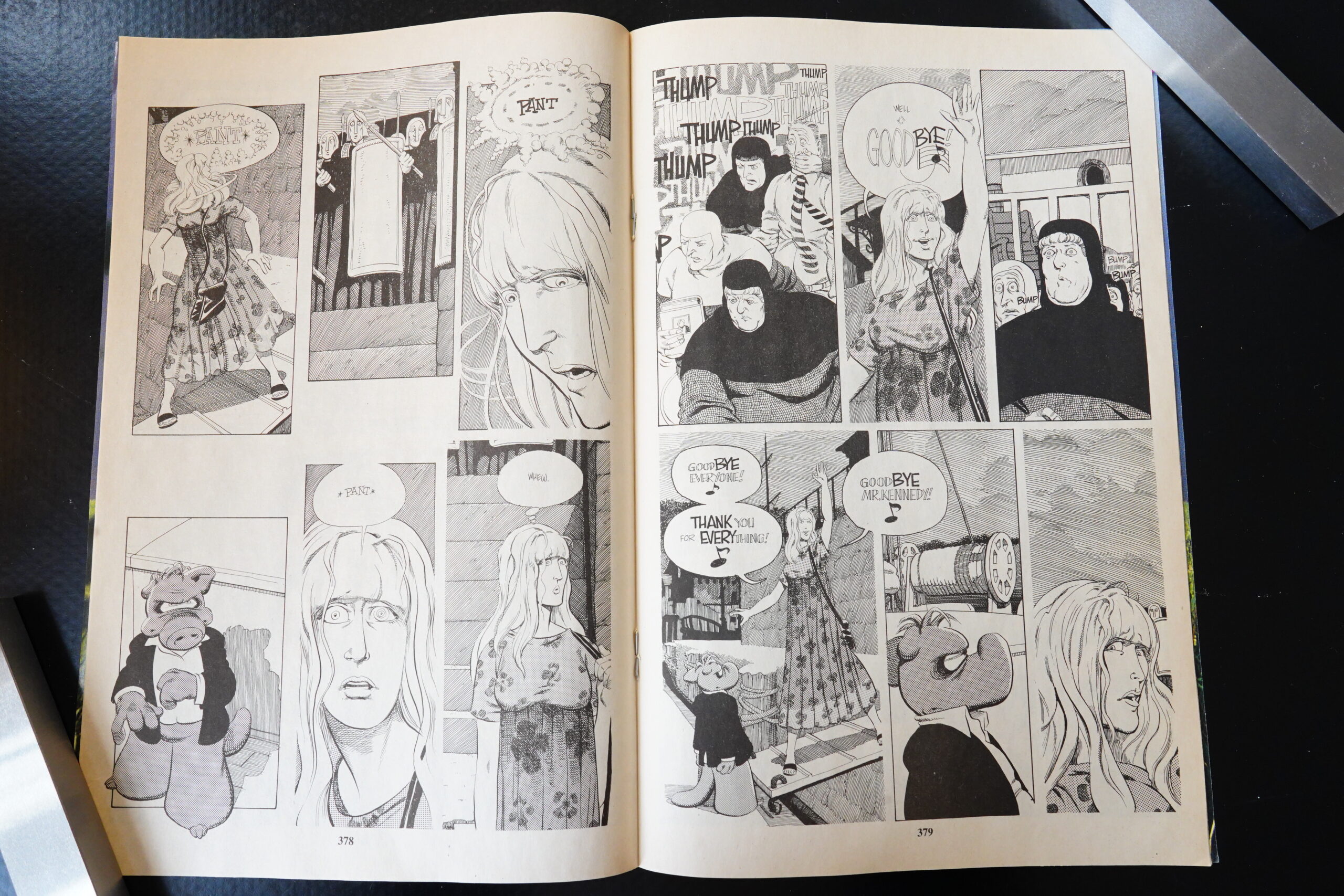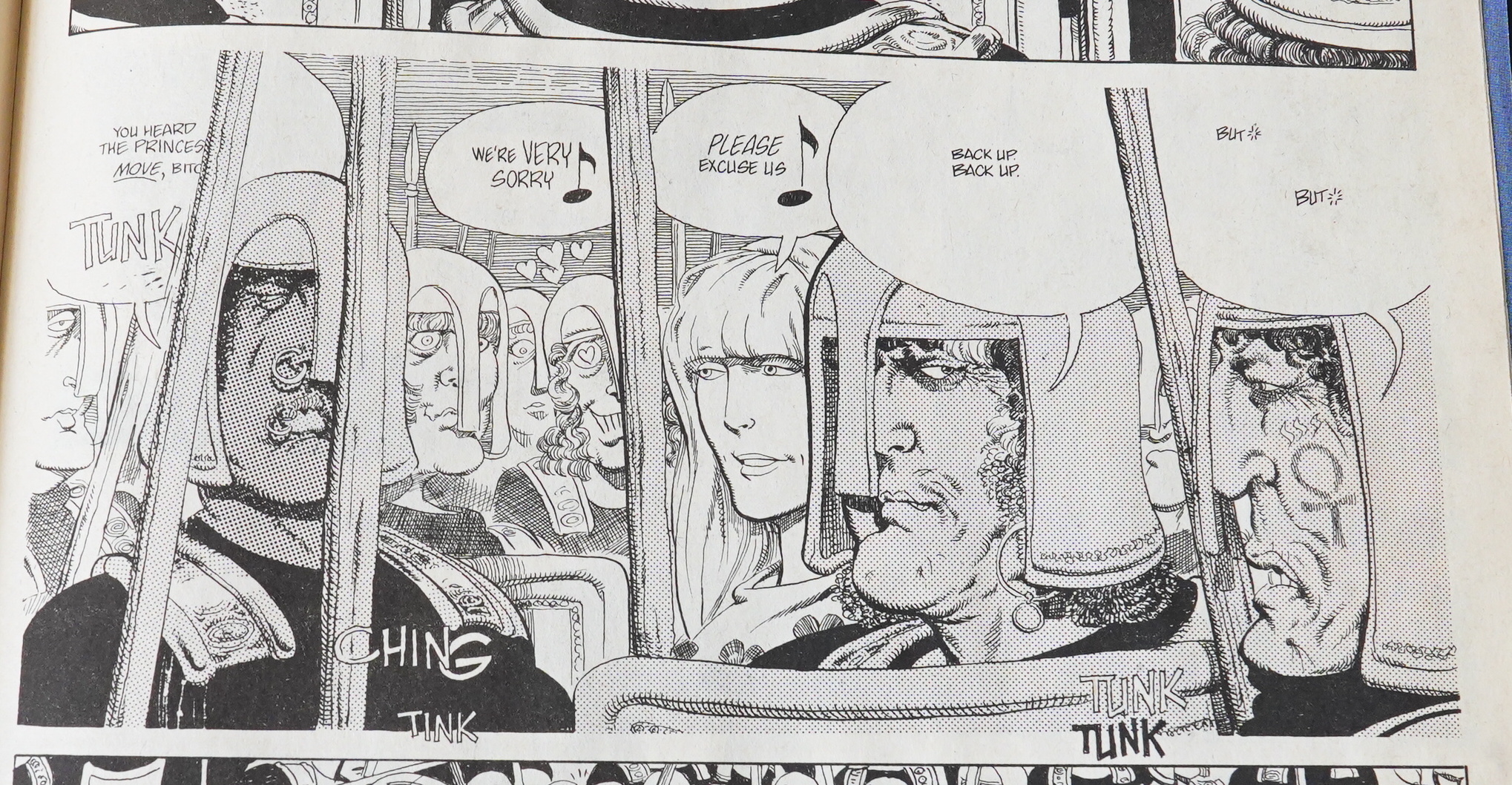Cerebus (1999) #240-250 by Dave Sim & Gerhard
This blog post is about Going Home book two: “Fall and the River”, and I have to admit to being pretty fed up with doing these posts (yet again). I should probably take a break, but at this point I’d rather power through. But you’ve been warned! If writing this is a slog, then reading it is probably going to be to, hein?
This book is mostly about F. Scott Fitzgerald (as well as Cerebus and Jaka taking a boat ride).
This entails Sim writing pastiches of Fitzgerald’s texts, and boy are they painful to read. Sim calls the texts “parodies”, but they aren’t really very funny: They’re just a bit on the bad side. Sim goes on (in the backmatter) about how to achieve what he thinks of as Fitzgerald’s overwriting, but the final result he ends up with sounds (more or less) like Sim writing like Sim usually writes: Pompous and smug.
And I remember reading this the first time around (in 1999). That is, I hit this page and I went “WHAT THE FUCK IS THAT UGLY TYPEFACE”. And I guessed that Sim wanted something that looked like a 20s typeface, but didn’t find one, and as Sim has extremely bad taste, he ended up with this monstrosity.
(Yes, I was a typeface nerd in the 90s.)
Jaka continues to grow ever more annoying.
The schtick in this book is that F. Stop Kennedy (the Fitzgerald character) writes a book about this boat trip, and he imagines what Jaka and Cerebus are doing most of the time: So we get to see what they really do, and then read a “fictitious” account that’s sometimes illuminating, and sometimes not. I didn’t really find this particularly fascinating.
Sim dispenses of the letters pages completely, and instead devotes the final four pages of each 24 page issue to writing notes (on a page to page basis) of what’s going on in the storyline, and his research into Fitzgerald. So… in a way we get the action three times: Jaka/Cerebus does something, and then F. Stop Kennedy writes what he thought they did, and then Sim explains what Jaka/Cerebus did and why Kennedy wrote what he did.
If you’re into text analysis, this is the book for you! The problem is, though, that not much of interest happens, so it’s a bit eh.
Oh, here Sim even mentions the typeface: “Footlight Light”. Hm… looks like this one? It’s a free font? No, it’s designed by Ong Chong Wah…
Doesn’t say when it was designed, but it sounds new, which I suspected:
Footlight is a highly distinctive face which began life as an italic. The designer then went on to produce the roman weights. It is unusual to draw the italic version first but this was done to impose a calligraphic influence on the face, and the slightly hand drawn feel remains evident in FootlightÆs roman version. The Footlight font family is of considerable versatility and charm, its originality makes it the perfect choice for advertising and magazine typography.
Ong Chong Wah was born in Malaysia, and studied graphic design in England. He worked as a designer in advertising for several years, and started designing type in 1984.
Hah! I wuz right back in 1999! Vindication! Or something!
Oh yeah, we were talking about Cerebus… Gerhard created a model that he took a lot of pics of to be able to draw it accurately, apparently.
The world Sim has set up doesn’t really make much sense: The Cirinists are rewarding three people by… allowing them to sit behind those screens and catch all The Exciting Action Happening When Jaka Is On A Boat. I’m guessing this is a comment on celebrity magazines and stuff — but flipping through People Magazine to read about Princess Diana isn’t quite the same commitment as being locked up in a cabin for weeks in the hope of seeing Jaka do something interesting, is it? I mean, exaggeration in satire is, you know, fine, but this is just kinda stupid.
F. Stop Kennedy functions as a kind of satanic figure — tempting Jaka away from he journey to Cerebus’ home town (and become a patron of an artists’ colony instead). But this also rather fails to carry all that much weight, because… she could just go up there for a month, and then go to the colony afterwards? She has all the time in the world.
Not a lot of mysterious things happen (less than in the previous book), but Rick appears to Cerebus, and apparently he’s now gone Full Bible, baptising people and shit.
I found this part interesting — over a couple of pages, we’ve seen F. Stop talk to Jaka about an introduction to a book she wrote. And here we have Sim’s explanation about what he apparently wanted to convey over those two pages. And I have to say, exactly… nothing… of what he writes here came over. I guess it’s nice that he’s got all this subtext, but he’s seriously off his rocker if he imagined he was successful in that sequence.
Some of the text excerpts are so (sorry for using hate speech) tedious that it’s hard not to just start skipping the text bits, and…
… it’s a parody of a sequence that Sim thought was particularly awful. Thank you, Sim! *rolls eyes*
Sim mostly keeps each issue to 24 pages, but for one issue he has to many notes that he expands the issue to 32 pages.
The Cirinists were (of course) extremely taken with the stupid and incoherent bit (which F. Stop improvised while fantastically drunk).
Hm… I thought Sim said that Cirinists had absolutely free speech? Did he change his mind?
And here we learn that, yes, men get more attractive as they get older, but women are always most attractive at seventeen. Oh wise one! Oh, by the way, this reminds me of today’s scandal, of which I have to say that as someone who has read detestable Red Room and the execrable X-Men Grand Design — I’m not surprised in the least.
(And perhaps I should stop writing about old comics, anyway.)
Gerhard innovates further — he doesn’t just have a physical model of the boat, but he’s also using 3D software? (Note the lamp standing in for Cerebus.)
You know, one major attraction in Cerebus used to be mysterious things happening, and then pondering What It All Means. But I have to say that at this point I don’t give a shit, because I know from experience with previous Cerebus things that it’s going to turn out to be something lame.
And this time around, we first get some silent pages with mysterious things, and then straight away we get some text pages explaining that it was lame.
This bit where we get a callback to what Dave told Cerebus at the end of Mothers & Daughters is a nice touch, though.
And this is kinda amusing — Sim muses on the common impulse to skip text pages when reading comics, and explains that this silent page/text page juxtaposition was a way to see whether he could entice readers to actually read the text pages.
Gerhard explains using computers and RU-486 to make the perspective less incorrect.
I know I’ve been bitching a lot during this blog post, and sure, Fall and the River is pretty boring, but it’s not the worst Cerebus book, really. It’s got sequences like the above (we’re seeing F. Stop’s delusions about his attractiveness contrasted with Jaka and Cerebus) which are really fun to read.
For the last few issues, the backmatter goes on a detour from doing page by page commentaries to being more of a generic Sim lecture on… er… stuff. (I stopped reading.)
And I have to admit that I didn’t quite understand the point of this Terimite thing was (or Jaka saying this? it seems so out of character? just so that Cerebus had to tell her that the Terimite thing didn’t really catch on in his hometown?), but like I said, I don’t really give a shit, do I?
Here Sim explains that he’s just extrapolating: Since we now have women’s shelters, we’ll later get a matriarchal society where a woman can have any man killed on her say so. Yeah, sounds like… extrapolation.
The book ends with Jaka saving Cerebus from being killed, and Cerebus being unaware that he’s even in any danger — which mirrors how the previous book ended. (And there their roles were reversed.) It’s not a perfect reversal, though, since this time it’s Jaka who almost got Cerebus killed in the first place by having an ambiguous conversation with the Cirinists (if I interpret things correctly; at this point Sim stopped doing the page by page explanations, so it’s up to the reader to figure out what’s happening here)…
And! As Sim says in the backmatter: This is the first Black character to appear in Cerebus. For one panel.
David Groenewegen writes in The Comics Journal #223, page 38:
It’s hard to make a case that Sim is playing
with his audience based on the female charac-
ters introduced in recent years. Most of them
have been Cirinists who exist only as straw
women, set up so that Sim can knock them
down. There hasn’t been a memorable one in
years, most of them serving as functionaries
and examples of womanhood gone out of con-
trol, The three that appear in “Fall and the
River” don’t even have names. There are also
throwaway references to the degenerative
power of women over artists, such as the sight
of R. Crumb being led meekly through the
docks by his Wife and daughter (p. 169). In
Going Home, the only woman we can use
to judge Sim’s views isJaka, because she is
the only one who can realistically be
described as a character.
She is, in fact, one of the most fully
realized characters Sim has ever done,
having come a long way from her first
appearance as a tavern dancer in the late
’70s. In many ways, she behaves exactly as
you would expect her to after reading
#186 — she’s manipulative, vain, self-
obsessed, maddeningly inconsistent, con-
stantly trying to redirect Cerebus onto her
own path rather than his. She won •t listen
to reason, and she goes into a sulk when
she can’t get new clothes. But, to be fair,
there are women like that in the world.
She’s definitely a believable character,
but the absence of any character to
counter the negative female stereotype
leads the reader to believe that the Views
of #186 are firmly held by Sim.
It also seems that Jaka will be easily
swayed away from a life with Cerebus (and
a pretty crappy life it sounds too), by the
blandishments of F. Stop Kennedy. Sim
hints that Jaka is on the verge ofdumping
him for a better deal. That she doesn’t,
and saves Cerebus without his actually real-
izing that she hus done so, is an interesting
twist. Jaka is suddenly portrayed as both
more aware and less self-centered than
Cerebus (despite him lecturing her about
her lack of discretion earlier). Of course,
Jaka has never been under any illusions
about the nature and extent of her
power. She has flaunted it before, usually
for her own selfish ends, most notably in
Jaka’s Story where she is able to save her.
self and Rick from the Cirinists. Does the
fact that she does it here make her the
hero of this part of Cerebus’ life, and
therefore worthy of a measure of respect?
Or is it just another sign of the fickleness
and emotional reasoning of women?
Illat this ambiguity exists is a signifi-
cant dent in the “Dave Sim: Evil
Misogynist” argument. Jaka is not all
“bad” — she is just a person. For Dave Sim to
be the woman-hater he is often portrayed as,
she would have to be as one-dimensional as his
views on women are claimed to be.
Does this mean that #186 was a colossal
joke, or a cunning ploy to balance out the
Judge’s explanation of the universe in Church
& State? Or is Sim just setting us up for some
grand denouement in which the relationship
between Jaka and Cerebus results in Cerebus’
destruction, thus “proving” #186? Personally, I
don’t know. Which is one of the reasons I like
Cmebus, and will keep on reading it to the end.
Sim keeps throwing in enough to keep you
guessing, and while I’m hardly champing at the
bit to read another one of his literary parodies
in Going Home II (Ernest Hemingway this time),
I’m smart enough to wait until the end of it,
and of Carebus as a whole, before I judge it.
I think the reviewer here is misreading Sim, though… Here’s Tim Kreider in The Comics Journal #301, page 362:
Most glaring is his hostility toward his female characters, especially Jaka,
the beautiful blonde daughter of the aristocracy turned tavern dancer who
is the great love of Cerebus’s life. In a note in 1988 Sim writes, “I admire
Jaka more than any of the other characters in the book,” and goes on to
describe her common sense, self-confidence, directness and lack of ma-
terialism; in an interview 18 years later he tells us: “Jaka is a self-absorbed
artistocratic airhead. She always was.” It’s that “She always was,” that’s
a red flag; it sounds like someone trying to convince himself, after a
breakup, not only that he doesn’t love his ex but that he never loved her.
It’s not only his attitude toward the character that changes over time; his
depiction of her becomes broader, more unforgiving. In Jaka’s Story and
Minds Jaka is intelligent, self-aware and passionately devoted to her art,
with a complex and fraught history privileged and imprisoned, over-
protected and molested. But by the time of Going Home and Form & Void
she’s become a caricature of everybody’s bitchy ex-girlfriend a selfish,
pouty shopaholic. This is dishonest art, a distortion of the character to
conform to the author’s biases.This same Soviet airbrushing of the history books is in evidence throughout
Cerebus, as when (usually female) characters suddenly reveal themselves not
to be who they’ve claimed to be all along (or, in some cases, turn out never
to have existed at all). This stripping away of layers of illusion and revela-
tion ofsome deeper, opposing tr’uth is an ongoing conceit throughout the
book. But I suspect Sim does this most often with women not only because
he believes they’re inherently duplicitous but because, more tellingly, he can
really only draw one attractive woman •—1 try telling Jaka, Astoria or Michele
apart without the visual cue oftheir hair and doesn’t want to have to intro-
duce new ones. (He does, however, command an endless repertoire of ugly,
hulking, hirsute, shrewish and bullying women. He draws a great Margaret
Thatcher.)
Bart Beaty writes in The Comics Journal #263, page 118:
Going Home
In I moved to Calgary, Where I
took a job as a university professor. I was
hired despite the fact that I made it clear
that I would be researching, among Other
things, comic books. They didn’t mind,
but no one really seemed excited by that
prospect. Theywe never let me teach a
course on the subject, for example, but, on
the other hand, never pushed that
hard for it either.
I continued to buy Cerebus every
month, but now at a clean, quiet, well-lit
Store near my new home. This was a
Cerebus store if there ever was one. They
had a Cereous shrine at the back, which
proudly displayed all the trades, surround-
ed by Cerebus posters (“the first half”) and
a few pieces Of Original art by Sim. It was
a nice set-up, and it convinced me that
this was a pretty decent store. The way a
store treats Cereous, it seems, is a sort Of
barometer for how well it Will treat inde-
pendent and art-minded projects general-
l”. If they don’t carry it, run. If they know
all about it, you’re probably in decent
enough hands.
I bought my last Cerebus at this Store
in March, stopping On a Wednesday night
as I walked With my wife to a movie
downtown. It was almost exactly 20 years
to the day since I had bought my first
issue, and in those intervening years I had
graduated high school and university
(three times), got a job, got married, and
bought a house. As we walked down the
street my Wife asked, “How does it feel not
be young any more?”
It felt odd.
The Comics Journal #301, page 367:
Although Sim’s dialogue is exemplary and his mimicry
perfect, his prose, I’m afraid, is not so great. I suspect that, like
Alan Moore, one reason he gravitates toward pastiches of Victorian
writers is because his own style naturally tends toward the purple end
of the spectrum. His imitation of Oscar Wilde is ornate and turgid to
the point of tedium. He’s tone-deaf to the austere beauty of
Hemingway’s prose, and his attempts to parody it only imitate the form
and miss its essence. In Going Home, when he presumes to rewrite
passages of F. Scott Fitzgerald to render them “more ethical,” his
insertion of flaccid qualifying phrases deprives the original of its
elegance and force —you could say he emasculates it.
Heh heh. Harsh but true.
There aren’t that many reviews of Going Home on the intertubes. Here’s Carson Grubaugh:
Going Home was my least favorite volume during this re-read. It felt like an unnecessarily long re-hash of a lot of things we already know by this point, primarily that Cerebus can be with Jaka and still be miserable.
[…]
This book also has the most god-awfully ugly art in the whole series. Immediately after reading the book, and determining that I hated Gerhard’s contribution to the volume, I started seeing people over on A Moment Of Cerebus comment that it is their favorite Gerhard volume. “Great,” I thought, “now I am really going to have to defend myself. So, bear with me as I explain my averse reaction to Gerhard’s art in Going Home.
That’s an interesting analysis of the book (and especially the shortcomings of the artwork which relies a lot more on Gerhard than in previous books).
The ending…and I kinda like this…the Cirinists are all set to make a move on Cerebus. Not Cirin herself (we never see her), but the thing is, the only thing keeping the Cirinists from moving in on Cerebus with a phalanx of female warriors is that he’s Jaka’s companion. And she seems much more aware of this than he is. It’s an interesting role reversal, in a lot of ways, because the last scene of the book has her saving Cerebus just by…being with him. Try as she might, Jaka can’t get away from being the “Princess of Palnu” – and now she’s the one that has the power. Kinda funny in a way.
OK, enough puttering around for today. Are there only three more blog posts to go? I hope so.
This blog post is part of the Renegades and Aardvarks series.



